Deadlands: Back East & The South by Libertad!
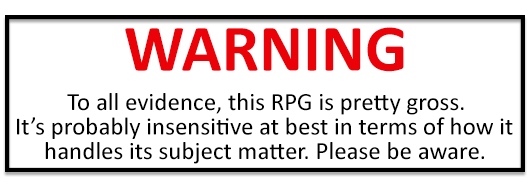
Introduction
Original SA post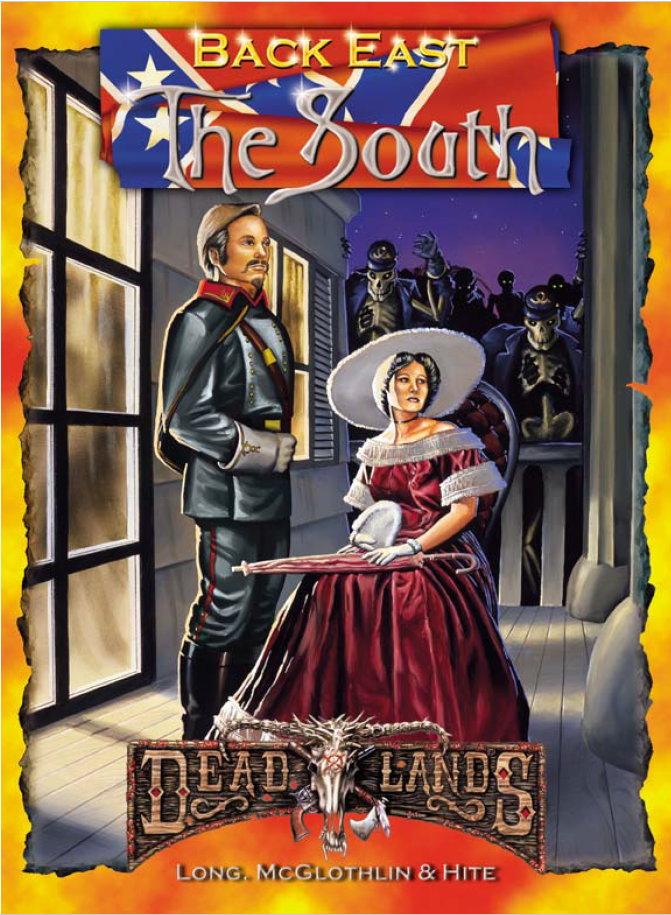
Introduction
This is going to be my first non-adventure review for Deadlands. After four of the major Plot Point Campaigns and the stellar Coffin Rock adventure, this is my first location/setting guide for the Weird West proper. Back East is a two-part line covering the Union and Confederacy east of the Mississippi. As most of the cool action is in the frontier, there has been precious few material on said regions besides these two books from 1999. There were plans to do updates for Reloaded for the Trail Guides series, but said project was scrapped due to publishing constraints. As such both Back East books still serve as the best insight into said regions.
But before we dive into the review proper, there is one big grey elephant in the room I must address. Deadlands is an alternate history of the late 1800s, where unleashed supernatural evils brought magic and monsters back into the world during the Battle of Gettysburg. Due to the fallen rising as undead, this setback turned history around in the Confederacy’s favor and they’re still an independent country with lots of territory as far west as Arizona. The most controversial decision among the gaming public is not just the writers keeping the Confederacy alive, but having said country voluntarily free all of their slaves without any hint of internal dissension. The setting ends up playing into the Lost Cause mythos by downplaying the real reason said nation seceded from the Union, and in some cases prettied up the legacies of said figureheads. One example is Robert E. Lee being portrayed as an heroic general, whose spirit comes to the aid of the PCs in a climactic battle during the Last Sons Plot Point Campaign. Or having the bloodthirsty first leader of the Ku Klux Klan, General Nathan Bedford Forrest, actually be a swell guy who happened to become possessed by an evil spirit in a saber which made him commit lots of atrocities.
As for why a whitewashed Confederacy, one of Deadlands’ main writers during the Reloaded era posted this explanation on the Pinnacle forums back in 2013:
Matthew Cutter posted:
The point is that players at the game table shouldn't have to play a game where sexism and racism are constant hurdles for their characters to jump.
If someone wants to run that game or play in that game, fine, but it's not the game we sell.
Maybe the scenario Shane and the original Deadlands creators devised doesn't "make sense" from the armchair historian's perspective, but it creates a milieu that's reasonably accepting of all races and creeds, which is great for an inclusive, made-up fantasy game like Deadlands.
So what's the argument here? That sexism and racism should be parts of the game? That characters who are female or black should be subjected to insults, indignations, and attempted lynchings in every game session? I think that would be awful.
Matthew Cutter posted:
Because we decided it would be that way to make the game playable. Period. It has nothing to do with historical facts or anything else. It's to make the game enjoyable to the widest possible range of people.
This subject has come up on rpg.net several times in recent memory, with the creators of Deadlands being accused of "Confederate apologism." So yes, I find the subject tiresome and borderline offensive, and I've seen many opinions expressed about it that are rather ugly. But that wasn't you; I apologize if my tone came across as hostility aimed in your direction.
firesuperioritycomplex, you've been given the in-game explanation, the practical out-of-game explanation (a few times), and have page references to all the Deadlands books that discuss it. Surely that's sufficient to satisfy your curiosity.
A lot can change in 5 years. While the Neo-Confederate movement always had that spark of racism in its devotees and the flag has been flown by bigoted groups for over a century, in 2017 the deadly Charlottesville Rally exposed to the general public far and wide just what kinds of people honor the Confederacy’s legacy. I’m hoping that when the SWADE version of Deadlands is made, the writers will be willing to either retcon or change this aspect of the setting so that this great game can be enjoyed by the widest possible range of people.
There might be hope for change. Back East: the South was written by three writers who live in various states in the region: Kenneth Hite, Steven Long, and Christopher McGlothlin. McGhlothlin was known as being a huge Neo-Confederate writer who inserted his love of the country into other RPGs, notably the Mutants & Masterminds book Worlds of Freedom. He doesn’t write anymore for Pinnacle Entertainment (Deadlands’ publisher) in recent years but Kenneth Hite does. And during the writing of the Deadlands Noir Companion, Hite actually retconned the Confederacy to be more explicitly anti-black. He wrote the Chicago chapter, and in taking a page from the Last Sons’ handling of the American Indian Wars he dispensed with the default "post-racial" setting assumption and deconstructed the South.
Although Noir still has a standing Confederacy, there was still a Great Migration north of black sharecroppers. In the Chicago chapter, a huge segment of the black population hate said country, and a popular black-run newspaper in Chicago was banned in publication down South. The CSA Embassy in Chicago is also very unpopular in the city by said residents.
Great Migration, Chicago Chapter posted:
That growth did not come without pangs. Urban poverty exploded, infant mortality skyrocketed. Offal and chemicals turned the river into a fizzy murk; coal smoke filled the air. Labor unions marched for the eight-hour day, fiery preachers called for reform and socialism, gangs warred over turf and protection, anarchists set off bombs and assassinated Pinkertons, and the big bosses cracked everyone’s heads in riot after riot. Despite all this, however, Chicago’s booming prosperity became a magnet for the black population in the Confederacy. Black sharecroppers poured North during Confederate President Wilson’s brief “New Opening” policy, seeking better jobs in Northern factories, which were plentiful during the war, and better race relations—which proved more elusive. White fear of the “Great Migration” triggered the worst riot of them all in 1919, which nearly burned the whole South Side to the ground, led to Federal intervention, and killed dozens of people. Nobody knows how many; the white administration didn’t want to find out, and bulldozed burned-out buildings over bodies without excavation.
Chicago Entries posted:
Chicago Defender: An entirely black-run and written weekly tabloid, the Defender covers Bronzeville and the other black neighborhoods of the city, exposing corruption and racism wherever it finds them. Staunchly reform Republican and hardline anti-Confederacy, the Defender never shies away from a fight.
It also runs extensive coverage of jazz, dancehalls, “race” movies and records, and other entertainment news, as it urges blacks in the South to “make the Exodus” to Chicago. Indeed, between such “subversion” and its aggressive reporting on problems in the Confederacy, the Defender is banned in the CSA. It battles this ban with an under-the-table, covert distribution network of railroad porters, stevedores, and house servants. (3435 S. Indiana)
Confederate Consulate: During the war, this threestory Italianate mansion was home to the copperhead publisher Wilfred T. Storey, who sold it to the Confederacy when peace broke out. Now it hosts the Confederate consul in Chicago, James Faulkner, and a hive of nefarious spies, Texas Rangers, and agents of influence. Despite that, its receptions are very popular with the local elite, not least because (like the British Consulate downtown) it can legally serve alcohol on its premises, which technically count as Confederate soil. Its location a mere four blocks from Chicago’s “Black Belt” ghetto occasionally attracts protest marches, riots, and other unrest. (1834 S. Prairie Avenue)
The KKK was also a thing in the Confederacy during the late 20s to early 30s. The CSA President at the time tried to reign them in, but this caused him to hurt in the polls:
CSA Presidents 1913-1956 posted:
1929-1932 — Oscar Underwood: A prominent anti-KKK campaigner, Underwood has the misfortune of holding office at the onset of the Great Depression in the CSA. In an attempt to combat the effects of the Depression on the South, Underwood makes several attempts to expand the power of the central Confederate government. Some were successful, most were not. Regardless, a combination of radical, often racist, opposition and the effects of the Depression limits him to a single term.
Part of me wonders how much of this is Pinnacle trying to go "yeah, a modern Confederacy still wouldn't be great for African-Americans" without out and out saying "sorry we f'ed up on this," versus Hite doing some subtle opposition. Either way, it shows that the Pinnacle writers are willing to retcon settings elements, and did as much in 2015 regarding decisions that caused fan backlash during the writing of Stone and a Hard Place. When juxtaposed with what Back East: the South attempts as a post-racial Confederacy, it’s quite striking to see one of its authors practically double back on this later on down the line. Here’s hoping they stay the course!
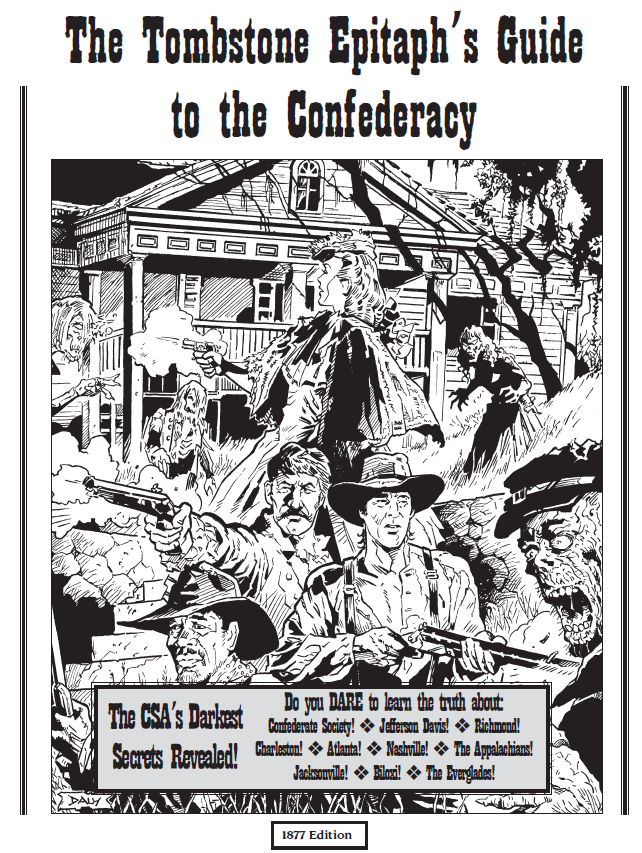
Tombstone Epitaph’s Guide to the Confederacy
A large portion of this book is written in an in-character period piece between three in-game authors (I wonder how they translate to the real authors’ regional experience). Writing for the Tombstone Epitaph, said paper is based on a real-world news publication and is clued in on many of the conspiratorial and supernatural events of the setting. They’re dismissed as a yellow journalism rag by many, but those in the know find it a reliable resource.
For the purposes of this Let’s Read, I’m going to denote special icons. Marshal’s Territory denotes the GM’s Eyes Only story behind a certain location or event; although in its own section later in the book, this can cause a bit of virtual page-flipping so I’m going to consolidate both into one section.
Secondly, in the interests of acting as a counter to the Tombstone Epitaph’s Rebel Bias, I’ll be publishing
 Libertad’s Red, Dead Guide to the True South,
Libertad’s Red, Dead Guide to the True South,  marked with the aforementioned teacher icon. It will showcase relevant elements from actual history, culture, and folklore of the South along with relevant sources I could find on the subject. It will also serve to point out some of the more unfortunate whitewashing elements.
marked with the aforementioned teacher icon. It will showcase relevant elements from actual history, culture, and folklore of the South along with relevant sources I could find on the subject. It will also serve to point out some of the more unfortunate whitewashing elements.quote:
In the Deadlands world, slavery (at least as an organized and accepted practice) is a thing of the past, and racism is not far behind it. Both the Confederacy and the Union have realized the errors of their past choices and abolished this foul practice.
Our reason for doing this is not to whitewash some of the horrible things which happened in America under slavery, but because they don’t contribute to a very fun gaming atmosphere. We also don’t wish to give the impression by that that we promote either of these things, as real a part as they are of American history.
The player’s section of Back East: The South is written in a decidedly pro-Confederate tone. But you should note that the characters portrayed as the author’s of the Epitaph Guide, while they may support the South’s war effort, have never supported the Southern plantation owners’ stand on slavery.
Racist characters that do appear in our books (like the Knights of the Golden Circle in this one) almost always play the role of villains. This may not be the most realistic way to portray people (hey, there are zombies in the game), but it’s the way that allows the most players to have the most fun.
A further note: because the player’s section is written as a period piece, we have used the term “Negro” when referring to people of African descent. This is not meant to offend anyone, it’s simply an attempt at avoiding anachronistic terms that might harm the tone of the writing.
Looks like they can already sense the readers’ impending judgment.
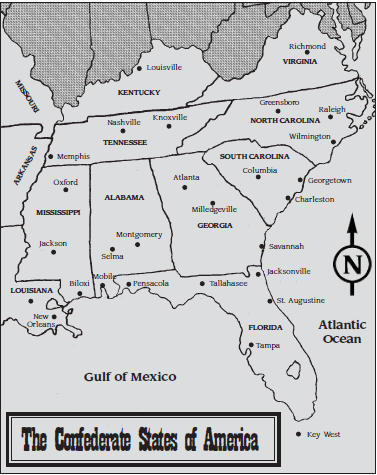
To Live and Die in Dixie
Our first section proper covers the Confederacy’s society and culture in general terms. It is a large diverse region ranging from the temperate hills of Appalachia all the way down to the subtropical marshlands of New Orleans. The South is a class-based society, with distinct social groups whose birth determined not just their economic means but also unwritten codes of proper behavior and expectations.
The first up are the Aristocracy, or Planter class. They’re less than 10% of the population and are the dominant political and economic force in the Confederacy. Although the USA and CSA both ban titles of nobility from being issued by the government, their name comes from the closed circuit of inherited wealth typically passed down the family tree, and also having an otaku level of obsession with aping the culture of British nobility.* Their wealth was gained via sprawling slave estates, and although they lost this purchasing power during Confederate emancipation they still have lots of pull and sway.
*Yes I know Calvin Candie was a Francophile, but I feel his character best exemplifies his brethren’s misplaced sense of European admiration.
Below the Planters are the Yeoman, landowning farmers who owned few or no slaves and often maintained small plots of land or lived on subsistence farming. Their lives are ones of constant work, and the life expectancies of women are short due to the high birth rate of families.
Finally there are African-Americans, (the book refers to them as “Negroes”) who at first were slaves and treated with all the cruelties of the real-world institution, but gained a great deal of upward mobility when the Confederacy emancipated them. The dragging on of the Civil War created a void in the labor markets and armed forces which freedmen quickly met. Although whites and blacks still live separately,* African-Americans are well respected for their contributions by whites and racist attitudes have been purged on a systemic level.**
*the book says part of this is by choice, but also mentions social pressure which indicates that the Deadlands’ Confederacy isn’t as progressive as the book otherwise claims to be.
**unless we count the mega-powerful and wealthy Knights of the Golden Circle, causing the book to contradict itself here.
 Poor Whites Social Class
Poor Whites Social Class So Back East forgot to include one very large and very iconic social group of the South. Poor Whites were the lowest social class of Caucasian Americans in the region. They owned no slaves and no land of their own, working as subsistence farmers or in manual labor occupations on land they rented from Yeomen and Planters. The Planters looked down upon the Poor Whites as uncultured, simple people, and the Poor Whites resented the elitism and wealth while someday hoping one day to make it big themselves.
So Back East forgot to include one very large and very iconic social group of the South. Poor Whites were the lowest social class of Caucasian Americans in the region. They owned no slaves and no land of their own, working as subsistence farmers or in manual labor occupations on land they rented from Yeomen and Planters. The Planters looked down upon the Poor Whites as uncultured, simple people, and the Poor Whites resented the elitism and wealth while someday hoping one day to make it big themselves.The Antebellum Aristocracy realized the dangers a large group of poor people with no social mobility possessed, so they exploited racial tensions as a means of pacifying the Poor Whites and Yeomen. Even the most impoverished white family had more legal rights and protections than even well-to-do freed people of color, and the former could take solace in the fact that at least they weren’t slaves. Additionally, the siren song of the American Dream was promoted in the owning of slaves, even a single one, as a status symbol. If you saved up enough funds to buy a slave you could be “somebody,” and maybe one day own a plantation of your own! This was of course a fantasy, and as the years went by more wealth and thus more slaves were concentrated into an ever-tightening circle of Planters.

Birth of a Nation
This section covers the founding of...ow! Wait, hold on a second! This really shrill dogwhistle was going off in my ear just now. This next section I’m going to quote heavily from, as it’s performing the RPG sourcebook equivalent of a Gish Gallop. Keep in mind that the default statement of Deadlands is that history as we know it proceeded normally up to 1863. Keep that in mind as we read on. That means that the Confederate states’ Articles of Secession, Vice President Alexander Hamilton Davis’s 1861 speech, and the Southern Aristocracy’s modus operandi were the preservation of slavery.
So you’re thinking that Deadlands is going to pull a “State’s Rights” justification on you, eh? Well, I did a CTRL F search for those two words or some variation of in the PDF, and I couldn’t even find a mention of the phrase anywhere! In fact, slavery’s Constitutional enshrinment and importance as an economic power makes more reference in this chapter.
quote:
In hindsight, the most reckless choice ever made by the American people came in the 1860 Presidential election, as the victorious Republican Party at best alienated and at worst infuriated each of the South’s social classes. The Republicans’ avowed opposition to slavery threatened the aristocracy’s wealth, while their various plans to repatriate slaves to Africa forcibly and subsidize Northern industry with taxes on the yeomen caused anxiety amongst Negroes and endangered the livelihood of most Southerners.
 Abolitionists and the Back to Africa Movement
Abolitionists and the Back to Africa Movement The question of the expansion of the slave trade and how to prevent it was a hot-button issue in the early to mid 19th century, as well as theoretical end-games once it’s been dealt with. The Back to Africa Movement was a proposal by various groups for the return of African-Americans to their ancestral homelands. Said movement has been championed by all sorts of people for different reasons, such as white supremacists who wanted to rid the US of an unwanted minority group; or civil rights advocates who believed that black people would more easily find freedom and self-determination in Africa than in the West.
The question of the expansion of the slave trade and how to prevent it was a hot-button issue in the early to mid 19th century, as well as theoretical end-games once it’s been dealt with. The Back to Africa Movement was a proposal by various groups for the return of African-Americans to their ancestral homelands. Said movement has been championed by all sorts of people for different reasons, such as white supremacists who wanted to rid the US of an unwanted minority group; or civil rights advocates who believed that black people would more easily find freedom and self-determination in Africa than in the West.Regarding a proposed forced migration by Republicans engendering widespread mistrust among African-Americans, I could find no reference of this. I checked the 1860 and 1864 GOP Platforms and found mention of ending slavery but no specific plans on what to do with said slaves or where they ought to live. Although racist sentiment existed even among radical abolitionists, many black slaves viewed the Union and Republican Party at the time positively in comparison to the Confederate states for the former granted them a better chance at freedom. It was not unknown for newly-freed slaves to join the Union army with intent to liberate their brothers and sisters from bondage.
quote:
Events following the election now seem inevitable. Led by South Carolina, the seven southernmost states seceded from the Federal Union, and formed the Confederate States of America. A peaceful separation was sought, but the Union chose to settle the political dispute with force, attempting first to close the vital Southern port of Charleston and then calling for 75,000 armed volunteers to coerce the Confederacy back into the Federal Union.
The latter move proved costly for the Union, as it provoked the secession of six more states, including Virginia, North Carolina and Tennessee. More importantly, Union aggression transformed the Southern yeomen from critics of secession into enthusiastic defenders of home and family, eager to repel the invading Yankee hordes. Without these added states and the support of the yeomen, the Confederacy would have died in its infancy. Instead, a long, bitter War for Southern Independence lie ahead.
So this section is lying by omission, although given that the section is written in-character I suppose this makes a teensy bit of sense. While it is true that the Union Navy put a blockade around Confederate ports on April 1861, earlier that very same month a Confederate military regiment fired the first shots at the Battle of Fort Sumter and thus officially started the American Civil War.
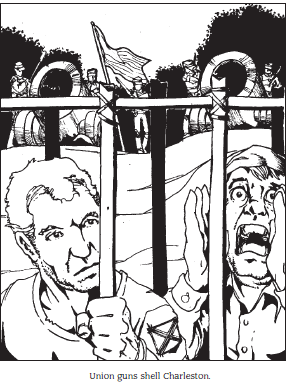
Several years into the war the Confederacy’s not looking good. Jefferson Davis was feuding with governors and military officers over controversial decisions such as conscription and suspension of habeas corpus. Their pockets filled with Planter money, the Confederate Congress issued a draft exemption for the owners of 20 or more slaves, spawning the phrase “A Rich Man’s War, a Poor Man’s Fight.” With the dead rising in Gettysburg the Rebels indirectly got a tactical advantage, but in doing so prolonged the war. As the industrialized, populous Union continued to batter the South, General Patrick Cleburne raised the proposal of freeing and arming slaves to fight, thereby gaining the moral high ground against the Union who in this reality hasn’t yet written the Emancipation Proclamation (they’d do so in 1865 in response to Confederate manumission). Cleburne had many critics, pointing out the Peculiar Institution’s economic reliance as well as being a Constitutional right.
But President Davis supported the idea, in that no price was too great to secure independence. Even though the nation was explicitly founded upon protecting slavery, so ummm... why are they fighting again? Eventually most of the Southern plantation owners came around to his line of thinking after Sherman’s March to the Sea resulted in countless towns and cities being razed to the ground. Cleburne’s proposal went through, and huge amounts of slaves volunteered for duty at the chance of freedom.
quote:
Negro hopes for emancipation by Union troops dimmed after the South’s 1864 victories, so Confederate military service seemed their best chance for freedom. Confederate Negroes volunteered in increasing numbers, eager to improve their standing in society by valor on the field of battle. From their first opportunity at the Battle of Fort Stedman, the freedmen have done just that, and now the only color most Confederates perceive in their Army is gray.
Unless they’re Indians of the Coyote Confederation who they’re at war with, or Apaches menacing Southern railroads, or Seminole fighters in the Everglades. Notice how the text subtly robs the Union of an otherwise progressive moral high ground by giving it to the Confederacy. This is not the only time this book, or Deadlands in general, will do this.
In recognition for this limited manumission, the British Empire and France recognized the Confederacy’s independence, broke the Union blockade with their own military forces, and supplied food, firearms, and other vital supplies to the Southern war effort. The British demanded universal manumission in exchange for continued support. The Davis Administration tried to do this, but once again he was faced with heavy opposition even from his own Vice President and Planters who hoped to pass laws to reinstitute slavery. Realizing the power they now had, an all-black regiment of South Carolinian soldiers sent a message to Cleburne that they’ll lay down their arms and refuse to fight as long as all of their brethren are still in bonds and denied suffrage. Cleburne took their side, threatening to surrender to the Union too unless the black soldiers’ demands were met.
There were no court-martials for anyone, or assassination attempts, or infighting against this act of treason, as all the Confederate officers magnanimously saw reason. Legions of black voters heading to the polls beat out the Planters’ pro-slavery bills, and somehow without any racist groups taking up arms or setting off dynamite at voting booths like what happened in the real Reconstruction and Jim Crow South. This universal manumission would become known as Jubilee in the Confederacy, signalling the death knell of the Plantation owner’s traditional hold on politics. They retreated from public life back into their stately manors and would never (officially) influence public affairs again.* The next big issue is women’s suffrage, which is looking more and more of a reality as the distaff gender fills in for the traditionally-male labor force fighting and dying in the prolonged war.
*the text contradicts itself in several areas later on this.
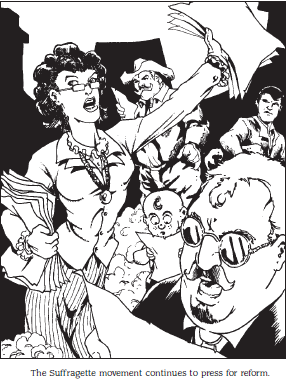
So, in the world of Deadlands, not only was slavery a huge economic and social force on Southern society, was backed by the richest and most influential members of the Confederacy, and a Constitutional right. Additionally, the President’s personality and policies made him clash heads with aristocrats and military officers alike. This leaves me with one burning question: whose dicks did Jefferson Davis have to suck in order to avoid assassination and impeachment?
 Jubilee Day
Jubilee Day Jubilee is a holiday which originated among the African-American community, marking the passage of the Emancipation Proclamation on January 1st. It is regarded as a “Black Independence Day,” marking the first significant gain in rights for them in American history. The holiday is celebrated in a variety of ways, but typically showcases art, history and culture. There’s also a subgenre of music known as Jubilee derived from slave songs containing themes of perseverance, freedom, and sorrow in a hostile world.
Jubilee is a holiday which originated among the African-American community, marking the passage of the Emancipation Proclamation on January 1st. It is regarded as a “Black Independence Day,” marking the first significant gain in rights for them in American history. The holiday is celebrated in a variety of ways, but typically showcases art, history and culture. There’s also a subgenre of music known as Jubilee derived from slave songs containing themes of perseverance, freedom, and sorrow in a hostile world.We get some brief info on Jefferson Davis himself, who is still sitting President after winning re-election and is a controversial figure even among Southerners. He’s viewed by fans as a principled hardworking man who won’t budge from what he knows is right, and his haters view him as a stubborn snob and bully. The man was blamed for all manner of ills during the first four years of the Civil War, but his popularity soared after earning British and French support along with capturing Washington DC during 1871 (they lost it later). Things took a dark turn in 1872 when he became more tyrannical. President Davis put Richmond and sections of the country under martial law, and those running against him in the 1873 elections met with mysterious deaths. He narrowly defeated Robert E. Lee after a suspended election in 1876, leading to many charges of voter fraud.
Marshal’s Territory: The real Jefferson Davis was killed in 1872 by a shapeshifting doppelganger, tasked by the Reckoners with making the war more desperate and bloody while also making the Confederacy a worse place to live. Members of his family, who long suspected the change in his disposition, were placed under house arrest in Mississippi, kept under close watch by Harrowed agents known as the Nightwatchers.
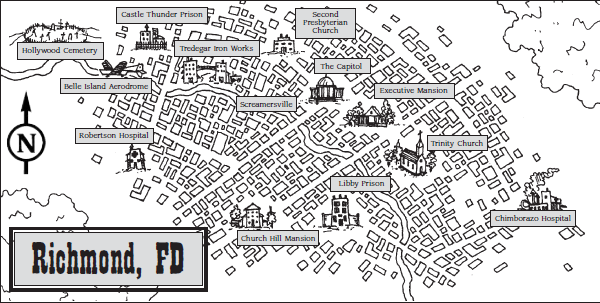
Richmond, City of Graves
Technically a chapter of its own, Richmond’s entry is short enough that I’m covering it as part of the original post. The capital of the Confederacy is located in Virginia and is just a hop, skip, and a jump from the US capital of Washington DC. Naturally the border’s securely guarded by a long Demilitarized Zone of no man’s land with barbed wire walls, cannon emplacements, and troops on the respective edges. Richmond’s population exploded from war refugees in 1863, and since the Southern Bread Riots the city still has a gloomy demeanor. This time it’s being on the front lines, and the large amounts of coffin-bound soldiers returning home has dubbed the capital the City of Graves. In fact, the graveyard’s grown so large that professional mourners make a living escorting families to their loved ones’ remains.
The Davis Administration rules directly in lieu of local governors, using the thuggish provost guard nicknamed “Pug-Uglies” to make arrests of even minor offenses. The Nightwatchers are the rumored secret police of Richmond, and they’ve been known to disappear people from their very homes in the middle of night. Sometimes the law doesn’t even have to get involved, as it’s quite common for aristocratic men to settle personal disputes via duels even though this is technically illegal. Capital Hill has a Whig majority in the House, who remain Davis’ greatest opponents, while the Democrats are the opposition party.
 Political Parties of the Confederacy, or Lack Thereof
Political Parties of the Confederacy, or Lack Thereof Although southern Democrats were the backbone of the pro-slavery sentiment, the Confederacy itself banned all political parties during its founding. Their rationale was that such organizations were dangerous to a democracy and would inevitably be bought out by moneyed interests. This did not prevent ideological blocs from forming within their Congress however, namely over the role of the central government during war-time.
Although southern Democrats were the backbone of the pro-slavery sentiment, the Confederacy itself banned all political parties during its founding. Their rationale was that such organizations were dangerous to a democracy and would inevitably be bought out by moneyed interests. This did not prevent ideological blocs from forming within their Congress however, namely over the role of the central government during war-time.Richmond has some interesting locations, too. Belle Isle houses the Confederate Flying Corps of ornithopter pilots, while Castle Thunder Prison holds spies, deserters, enemy combatants, and other POWs. The Church Hill Mansion is home to Elizabeth Pew, who is universally hated in town for being a supporter of the Union cause but somehow has not been arrested from martial law.
Marshal’s Territory: Castle Thunder is a realm of misery and torture, and the Nightwatcher’s leader is known to carry out interrogations here. One of the local newspaper journalists is held here, mistakenly believed to have ties to pro-Union elements. The Nightwatchers also have a doomsday scenario to blow up huge reverses of gunpowder beneath the city’s key points in the event of Doppelganger-Davis’ assassination or a Union takeover of Richmond. There’s an undead serial killer known as the Exsanguinator whose wife turned to prostitution after becoming a widower; he kills her clients for “defiling” her, causing the poor woman no end of fear and heartache. Finally, the famed priest Moses Drury Hoge prayed at the bedside of Robert E. Lee, using Blessed* powers to save the general from death. He is also a member of the Chaplain Corps, a group of Christian Confederate Blessed who were formed in 1863, and the Union has no equivalent organization besides the non-governmental Order of St. George who reports to the Vatican.
For those not in the know, a Blessed is one of Deadlands’ “spellcaster classes,” holy men and women empowered by the Almighty to deliver miracles. They are non-denominational and can appear among various religions, but given Deadlands’ Christian symbolism it’s pretty much presumed that the Abrahamic God is giving them their powers.
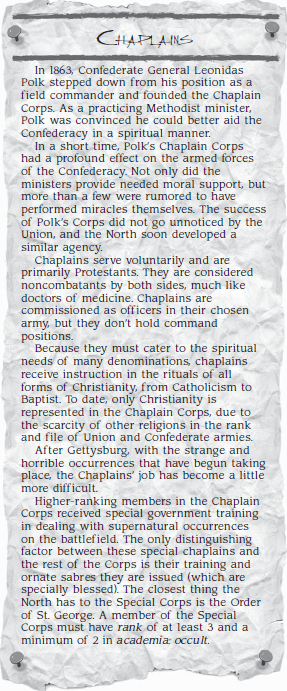
This sidebar is in Fire & Brimstone, but is relevant to bring up here. Meaning that the Almighty gave Confederate, not Union, soldiers said powers. In 1863, which in Deadlands’ timeline was before even black soldiers were employed for manumission. Meaning that the major force for good in the setting was okay with supporting a government upholding race-based chattel slavery at the time.
 DEEEEEEEEEEEEAAAAADLAAAAAAAAAANDS
DEEEEEEEEEEEEAAAAADLAAAAAAAAAANDS
Thoughts So Far: This opening chapter is a mess. Even in the context of its whitewashed alt-history there are some huge holes in logic. Not only was the Confederacy founded upon protecting slavery without mention of State’s Rights, it later gave up its raison d'être surprisingly easily. The aristocracy and plantation owners seem all too willing to give up the ghost, not resorting to every dirty trick in the book like they did in real life to hold onto their economic dominance. Deadlands is no stranger to rich assholes lining their pockets off of human misery; it’d seem ludicrous if any of the Great Rail Wars barons had a crisis of conscience and tossed in the towel due to moral reasons alone, or for Dr. Hellstromme to shut down his company when he realized that his products are hurting people. And this isn’t a paltry sum of money, either: slaves represented 16% of the pre-Civil War United States’ assets, worth more than all the banks, factories, and railroads put together. We’re talking what would in modern times be equivalent to trillions of dollars.
Forget the Reckoner doppelganger! Every Planter would’ve wanted Jefferson Davis’ head on a silver plate, and no price would’ve been too high to pay for any group of assassins or terrorists to do the deed. In the half-assed attempt at sanitizing the Confederacy while keeping in its real-world reasons for secession, Back East creates a country that went from fighting for an evil cause to fighting for nothing at all. The villains of the Antebellum South are all too easily forgiven, strangely eager retreat from public life in spite of their vast social power, the black freedmen and women either silent or blind to the discussion for redress of the evils inflicted upon them. In spite of using the Black Confederate soldiers meme as an in-universe explanation for gradual elimination of racism, we only get the name of the one South Carolinian who threatened surrender (Captain John Buckner), with much of the praise and glory in-character heaped upon the white officers General Cleburne and Lee in most of the sourcebooks.
Join us next time as we cover the Front Line States, the troubled border regions facing the brunt of Union firepower!
The Front Line States
Original SA post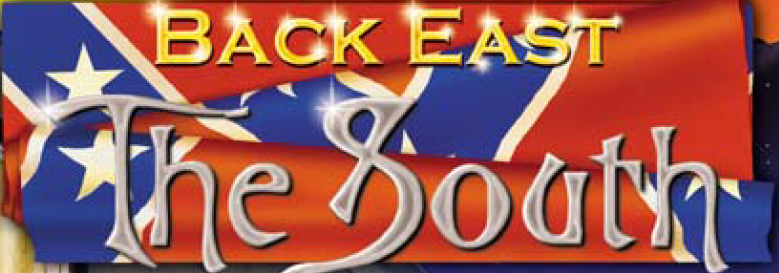
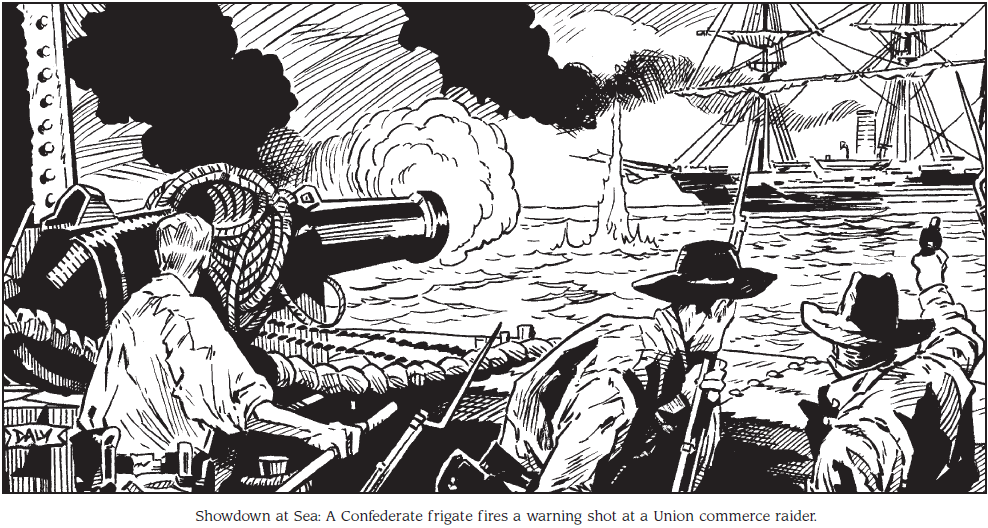
2. The Front Line States
Although Bleeding Kansas sees heavier fighting, it is already covered in great detail in other Deadlands works, so this chapter covers the ones east of the Mississippi. The following three states see the heaviest fighting with Union soldiers.
Virginia, the Old Dominion
The Epitaph reader would’ve included West Virginia, regarding it as an occupied territory, but due to said situation is only able to cover its original eastern neighbor.
Virginia’s home to the Gosport Navy Yard which is the lifesblood of the Confederate Navy, and recent developments in the CSS Hunley prototype submarine and its swashbuckling gentlemen officers led to popular tales in newspapers and dime novels.
 Submarines in the American Civil War
Submarines in the American Civil War Although Deadlands’ ones are ghost rock-powered steampunk ships, the real-world submersibles of this era were small, cramped hand-powered contraptions. As of 1866 only 5 of them existed in the world (mostly in Europe). The CSS Hunley saw practical use in sinking vessels, but met its end in an explosion likely due to a malfunctioning torpedo.
Although Deadlands’ ones are ghost rock-powered steampunk ships, the real-world submersibles of this era were small, cramped hand-powered contraptions. As of 1866 only 5 of them existed in the world (mostly in Europe). The CSS Hunley saw practical use in sinking vessels, but met its end in an explosion likely due to a malfunctioning torpedo.Beyond this, other strange events in Virginia include a group of bandits tossing experimental gas weapons into homes to loot the families’ unconscious remains, ships disappearing in the Bermuda Triangle that Northern muckrakers attribute to Confederate witchcraft, colorful UFOs spotted at night near the lead mining town of Wytheville, and a mysterious spate of murders around the town of Saltville.
Marshal’s Territory: An ancient portal device beneath the Bermuda Triangle provides a gateway to stars and planets beyond known space, causing all manner of unearthly weather. The “mad gasser” bandits are lead by a mad scientist who created an experimental sleep gas to become the ultimate burglar. The UFO spotted near Wytheville is the result of a dentist-turned-mad-scientist working on an air carriage he stole from his business partner. The culprits behind the Saltville murders are a unique strain of vampires who absorb salt nutrients from their victims.
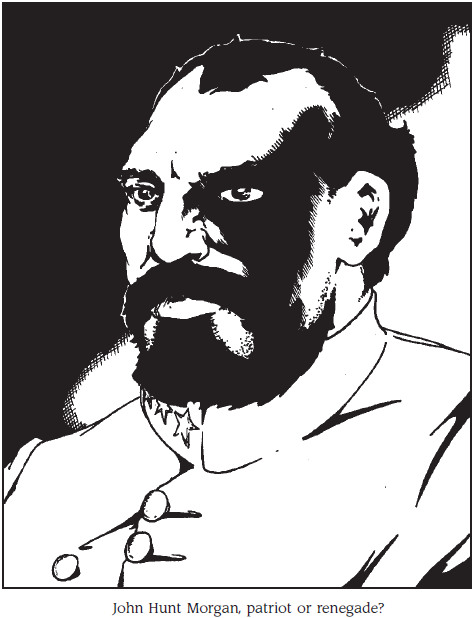
Kentucky, the Bluegrass State
A state of many faces, Kentucky’s western half sees heavy river trade along the Mississippi. Its central portion has been turned into barren wasteland from Union offensives, while its mountainous east is isolated from much of the world. General Sherman razed the city of Louisville and now the ruins act as a Union supply line. The charred remains are still inhabited by some creature feeding off of the burnt corpses.
One of the most famous people here is General John Hunt Morgan, who earned a great reputation among Kentuckians for his courage and keen tactical mind. The fact that he narrowly escaped a Union cavalry ambush while being court-martialed by fellow Confederates for “being a loose cannon” only further added to his rebellious mystique.
Marshal’s Territory: Unsurprisingly, General Morgan is now a Harrowed, an undead whose body is shared by two souls: an evil spirit known as a manitou and the soul of its original owner. Although he still leads volunteer forces against the Union, he is on a self-imposed exile due to the unpredictable nature of his manitou half. The Louisville Beast is a transformed human by the name of Mark Metzner who creeps among the ruins of his hometown and ambushes Yankee soldiers to kill and eat.

Tennessee, the Volunteer State
The book notes that Memphis and western Tennessee have been extensively detailed in another sourcebook, so it’s only covering the east. Specifically Knoxville and Nashville, the latter of which gets the lion’s share of the state’s word count. The city is a major railway in the region, and home to prestigious medical colleges. But unfortunately the presence of Yankee soldiers in the 1860s tarnished the Athens of the South with a new scourge…
Prostitutes!
Now known as the City of Sin, wiley temptresses in Smokey Row ensnare men and their hard-earned money by the thousands! The spread of STDs manifesting in welts is taken as evidence of God’s divine wrath, and the Epitaph writer is inclined to agree.
 Legalized Prostitution in Nashville
Legalized Prostitution in Nashville In spite of the Tombstone Epitaph’s moralizing, the temporary legality of prostitution had an overall beneficial effect for both sex workers and clients. Due to a high number of widows and women who overall lost secure financial holdings, the world’s oldest profession grew with the onset of young male soldiers coming into towns. What made Nashville different was that initially the government tried to forcefully expel its sex workers due to the spread of STDs from the occupation which bedridden countless soldiers. When that didn’t work, and the exiled white prostitutes were replaced with black women and thus contributed to the far greater “sin” of race-mixing, the riverboat-bound ladies of the evening were welcomed back into Nashville.
In spite of the Tombstone Epitaph’s moralizing, the temporary legality of prostitution had an overall beneficial effect for both sex workers and clients. Due to a high number of widows and women who overall lost secure financial holdings, the world’s oldest profession grew with the onset of young male soldiers coming into towns. What made Nashville different was that initially the government tried to forcefully expel its sex workers due to the spread of STDs from the occupation which bedridden countless soldiers. When that didn’t work, and the exiled white prostitutes were replaced with black women and thus contributed to the far greater “sin” of race-mixing, the riverboat-bound ladies of the evening were welcomed back into Nashville.Provost Marshal George Spalding decided that if prostitution cannot be rid of, then the next best thing is to ensure that both sex workers and soldiers could satiate their desires in a safe and sanitary manner. Hospitals and free healthcare was set up for the former as long as they submitted to weekly health checks, and those found ill would be treated at said hospitals. Many soldiers felt elated when escorts touted licenses and literal bills of clean health.
The other major feature of Nashville is the Cumberland Queen riverboat, home to high-stakes gambling tournaments and a secret organization of Hucksters known as the Court who serve the Reckoners. Nashville’s most prominent attorney is Howell Beasley, whose family made a fortune off of the cotton (slave) trade and hosted an extravagantly wealthy wedding. He’s running for city councilman against a black lawyer James Napier, and his deep pockets are making him well-to-do in the city.
Marshal’s Territory: The red welt “STDs” are actually curses from a succubus seeking to spread fear and terror by casting blame on sex workers. Howell Beasley is the leader of the Knights of the Golden Circle, a secret society of Reckoner-supported white supremacists who seek to return to the slave days of yore. Howell’s using his funds to expand the Knight’s influence in Nashville, and views Napier’s candidacy as a threat to the social order. He’ll resort to all manner of dirty political tricks to secure a victory, including assassination if need be.
Our last major feature in Nashville, and this chapter, are the city’s famed Machine and Powder Works, known simply as “the Works.” The efficiency of the mostly-black workers is second to none due to their gratefulness to General Cleburne, and the betrayal of the Union:
quote:
On New Years’ Day 1863, Nashville slaves fled their masters en masse, believing themselves freed by the Emancipation Proclamation, but to their anguished surprise, Union authorities forcibly returned them to their owners.
Unbeknownst to them, Tennessee’s Union governor Andrew Johnson exempted occupied portions of the state from the Proclamation, and Nashville’s Negro population never forgot this betrayal. Almost two years later, a shattered Federal army fled to Nashville after crushing defeats by General Cleburne’s Confederates at Spring Hill and Franklin. Slaves knew of Cleburne’s promise, “Whosoever joins with me, I shall set free,” and many prayed for his triumph to win their freedom.
The Battle of Nashville eliminated the last vestige of Union authority in Tennessee, and afterwards Cleburne proved as good as his word. While it made him enemies among Nashville slave owners, the city’s Negroes rallied to his side, including many who now labor at The Works. As a result, every attempt to sabotage The Works has been thwarted by the workers themselves, and Cleburne’s army wants for little in the way of materiel. It’s the least they can do, many say, to repay “The Stonewall of the West.”
 African-Americans in Tennessee
African-Americans in Tennessee Let’s get one thing straight first. Andrew Johnson was a huge asshole and a significant barrier to social progress during his Presidency. And while Tennessee under his watch did exempt the state, this decision was soon overturned on account that slavery was a clear and present danger to the Union. Additionally, many African-American troops in the state who joined the Union Army at the time gained some increased social standing, although sadly this did not last post-war.
Let’s get one thing straight first. Andrew Johnson was a huge asshole and a significant barrier to social progress during his Presidency. And while Tennessee under his watch did exempt the state, this decision was soon overturned on account that slavery was a clear and present danger to the Union. Additionally, many African-American troops in the state who joined the Union Army at the time gained some increased social standing, although sadly this did not last post-war.Once again an otherwise sorta-progressive action by the real-world Union is erased so that Deadlands’ Confederacy can gain the fictional moral high ground!
Thoughts So Far: At a mere 8 pages, this chapter’s surprisingly light on details. Beyond Nashville we only get a skeleton view of said states’ culture, terrain, and historic places. Most of the word-count is devoted to strange events and localized goings-on. While in keeping with the Weird Western flavor does not do a good a job at making the states feeling uniquely different from the West, or the rest of the Confederacy for that matter.
Join us next time as we venture to the Carolinas!
The Carolinas
Original SA post
3. The Carolinas
Hell yeah, we’re gonna be visiting my home state in this chapter! Covering both North and South Carolina, this chapter’s far larger than the preceding one, and is full of content.
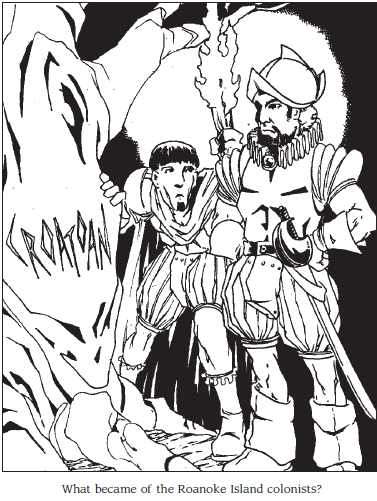
North Carolina, the Tarheel State
North Carolina gets the above state nickname from the natural resources of vast pine forests teeming with tar, turpentine, and pitch. There are various stories for who coined the phrase, but during the American Civil War it became associated with bravery and standing firm as though one’s heels were stuck to the ground by tar, or a mocking phrase the North Carolinian troops made in joking about the cowardice of retreating Virginian soldiers. Back East, naturally, sticks with the one coined by Robert E. Lee.
The state is divided between the low-lying coastal plains to the east, the Piedmont plateau dominating the center full of rolling hills bursting with fertile clay-like soil, and the Appalachian Mountains in the west. The Cherokee and some small isolated bands of Native Americans still live in the west and central regions, although their numbers were brought low by a mysterious plague known as the Walking Death (which I could not find in a Google search so I presume it’s a Deadlands creation). In fact, North Carolina contains one of the country’s longest-lasting mysteries in the Lost Colony of Roanoke. British colonists made a small village in the sixteenth century here, and it was in fact the first attempt at a permanent English settlement on the continent. Lack of supplies and hostile relations with local indigenous people forced Sir Francis Drake and others to leave. After much delays and government red tape did Sir Drake return, only to find the colony abandoned, the word CROATOAN (the name of a local tribe) carved into a nearby tree as to the only possible clue. To this day there’s many theories as to what happened, but no conclusive evidence.
Marshal’s Territory: In the world of Deadlands, the white colonists went inland to live among the Croatoan tribes to survive and intermarried among them. However, their memories of the colonists who left them became bitter:
quote:
They didn’t go quietly, though; they told their children about how white men “abandoned” them. Today their degenerate, hate-filled ancestors still live there in the deep swamps, eager to capture and kill other whites as a way of getting revenge.
Unless there’s some undead chicanery going on, don’t they mean descendants, not ancestors? Also the degenerate swamp-people trope from “going native” isn’t a good look.
 Cherokee of North Carolina
Cherokee of North Carolina During Andrew Jackson’s Presidency, the Cherokee and other tribes were forcefully driven off their land in a devastating event known as the Trail of Tears. The US military forcefully relocated them to various areas west of the Mississippi onto reservations, the tribe members forced to march without adequate food and supplies which lead to a high death rate. The Cherokee who remained behind in North Carolina managed to do so by assimilating into white society and renouncing tribal citizenship. As of today they live in the western portion of the state in a special reserve of territory which is not a reservation but a land trust. It’s also home to the only non-lottery form of legalized gambling in North Carolina via casinos which help tourism.
During Andrew Jackson’s Presidency, the Cherokee and other tribes were forcefully driven off their land in a devastating event known as the Trail of Tears. The US military forcefully relocated them to various areas west of the Mississippi onto reservations, the tribe members forced to march without adequate food and supplies which lead to a high death rate. The Cherokee who remained behind in North Carolina managed to do so by assimilating into white society and renouncing tribal citizenship. As of today they live in the western portion of the state in a special reserve of territory which is not a reservation but a land trust. It’s also home to the only non-lottery form of legalized gambling in North Carolina via casinos which help tourism.We get a detailed three-page write-up of North Carolinian history during the Civil War. To summarize it was home to many skilled blockade runners who helped deliver supplies to and from the Caribbean and Europe, and many runners made vast personal fortunes from this. The Union navy built seaside fortresses along the Outer Banks, a long-running chain of barrier islands covering most of the state’s coastline, which in turn made this process very difficult. But the Confederate victory on the Battle of Fort Fisher (the Union won IRL) destroyed one of the North’s most strategically important coastal strongholds in the region. The deployment of mechanized cavalry known as steam behemoths helped the Confederacy win a decisive battle in the capital city of Raleigh, leading to the surrender of a thousand disorganized Yankee soldiers.
As of now the Union holds the cities of Washington and Plymouth in the Northeast, and still control most of the Outer Banks. But besides this the rest of the state’s Rebel Country.
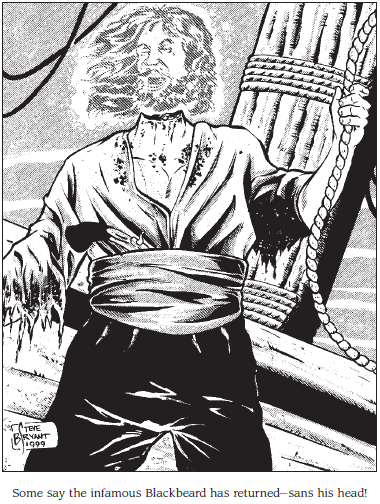
A Look at North Carolina: the Coastal Region
This is the most developed and populated region of the state*, and is home to many coastal villages and towns. The legendary pirate Blackbeard once prowled these waters, and many folktales and rumors claim that he still sails to this day in a ghost ship! Wilmington is the largest and busiest city in the state,** and its railways are active at all hours shipping supplies to the front lines of Virginia. Unfortunately the wealth flowing in, along with arms and ammo, has attracted many criminals and spies hoping to sabotage and profit by skimming off the top. The humidity of the place along with the high population of cities makes Wilmington vulnerable to epidemic outbreaks, and a nasty case of yellow fever hit the place a few years ago.
*but in modern times the Piedmont has the honor of this designation, **while Charlotte would become the state’s most populous city today.
Marshal’s Territory: A monster known as a Pox Walker is responsible for the yellow fever outbreak. Its form has been seen creeping about at night by some locals, but as most see it through the windows of shuttered homes precious few know of its true nature.
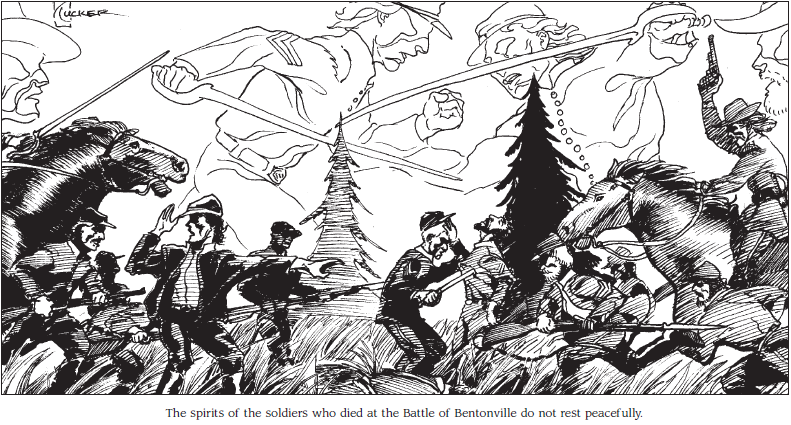
A Look at North Carolina: the Piedmont
The literal heartland of the Tarheel State, the Piedmont boasts the most prosperous farming territory as well as Raleigh, the city’s capital. The latter boasts the proud St. Mary’s College, and the Dorothea Dix Hospital for the insane. Johnston County to the south holds a huge amount of ghosts and spectres due to hosting the most vicious battles in the state. Unable to find closure, uniformed Yanks and Rebs will rise from their shallow graves to play out their deaths again and again, sometimes adding unlucky living souls to the number of casualties.
Marshal’s Territory: An insane asylum escapee by the name of Dr. Abbington broke out of Dorothea Dix hospital and is now a serial rapist abusing his authority at St. Mary’s College. He uses social connections to get his victims committed to the asylum. The restless ded in Johnston County have a supernatural pull on living people to commit to the fighting on a failed Spirit roll, where they will join one of the spectral sides.
The other notable population centers include the university town of Chapel Hill which draws in a huge amount of students from across the country, and Greensboro which houses the Alspaugh Armory that develops some of the biggest advancements in Confederate military technology. A barren circle of land in a forest known as the Devil’s Tramping Ground is rumored to be the regular vacation spot of Satan himself when he chooses to visit the mortal world. The Uwharrie Mountains are home to culturally isolated villages who set up shop to mine for gold in the 1850s, and later ghost rock during the 1870s. Uwharries inhabitants have a peculiar kind of healers known as thrash doctors. They are children who’ve never seen their father’s face and thus gain supernatural powers as a result.
Marshal’s Territory: Most of the ghost rock mines are owned by the Knights of the Golden Circle who use the profits to finance their evil schemes. The Circle’s leader in the region is an Alabama aristocrat well-versed in Appalachian witchcraft. Being a Thrash Doctor is a 3-point Edge where you can spend a fate chip to cure illnesses (with more serious maladies corresponding to higher ranks of said chips), but are slower-acting than typical magic and thus the healing takes place in 24-48 hours. One of the urban legends around Chapel Hill involves a student by the name of Peter Droomgoole, who died in a duel fought over a woman’s hand. He was ironically buried underneath a rock where he and his lover regularly met. In Deadlands this is true, but he did not die; he was left for dead but dug himself out of his grave, becoming a crazed cannibal who hunts people in the nearby woods.
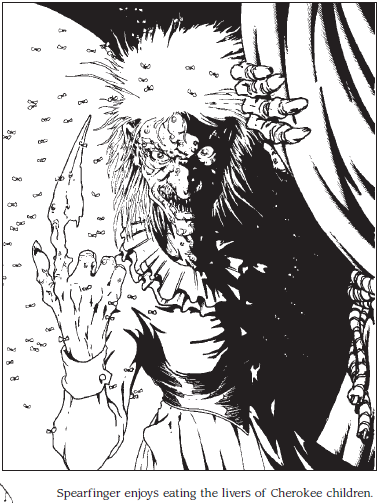
A Look at North Carolina: the Mountains
The least-populated region of North Carolina is home to tough, rural mountain folk and the Cherokee tribespeople. The mountain folk are descendants of Scots-Irish immigrants along with people from many other walks of life. They’re more likely to have Union sympathies than the rest of the population, and typically make their living farming, hunting, fishing, and mining where mineral veins are rich. The mountain folk are often ruled over by the richest inhabitant known as a “King,” and the most isolated reaches of the mountains are home to witches who can curse farmland and livestock. But what’s even more monstrous are literal giants, some multi-headed but all standing between 14 to 30 feet tall. Old Fire Dragaman is the largest and angriest of his kind, who lives in a gigantic hole in the ground complete with its own fields and cabin. True to his name, he can also breathe fire if he gets really mad. Although the rest of the population regards such monsters as tall tales by superstitious Appalachians, in the world of Deadlands these beings are all too real.
 Appalachian Folklore
Appalachian Folklore The concept of a “granny witch” dates from Scots-Irish immigrant traditions, of elderly women skilled in herbalism and trial and error home remedies. Due to geographical isolation, poverty, and lack of roads, hospitals were rare and hard to reach. This forced Appalachian people to rely on granny witches for succor. Many of these women were regarded as having magical powers, but this did not necessarily conflict with Christian traditions due to their sheer necessity and they were more akin to “cunning folk healers” of medieval times.
The concept of a “granny witch” dates from Scots-Irish immigrant traditions, of elderly women skilled in herbalism and trial and error home remedies. Due to geographical isolation, poverty, and lack of roads, hospitals were rare and hard to reach. This forced Appalachian people to rely on granny witches for succor. Many of these women were regarded as having magical powers, but this did not necessarily conflict with Christian traditions due to their sheer necessity and they were more akin to “cunning folk healers” of medieval times.Archeological expeditions in the 1700s and 1800s unearthed the bones of very tall humans, creating rumors that a race of giants lived in eastern North America. They ranged from a more realistic 6.5 to 7 feet tall than the towering creatures in Deadlands.
 Bushwackers and Scalawags
Bushwackers and Scalawags The mountainous country of the Appalachian Mountains were ill-suited to the slave economies of the traditional Antebellum, meaning that the Planters more or less let the land be given over to Poor Whites. Although not necessarily abolitionists, the wealth and infrastructural development of state appropriations afforded to their lowland neighbors created no small amount of resentment among the mountain folk. West Virginia was formed in no small part due to this, and the largest amount of native white Southern soldiers serving in the Union army were located in states touching the Mountain range. The partisan warfare in Appalachia was less conventional armies and more scattered groups of guerrilla scouts tracking down or avoiding each other in the wilderness for days and weeks at a time. Pro-Union Appalachians were called Scalawags, and pro-Confederate ones Bushwhackers.
The mountainous country of the Appalachian Mountains were ill-suited to the slave economies of the traditional Antebellum, meaning that the Planters more or less let the land be given over to Poor Whites. Although not necessarily abolitionists, the wealth and infrastructural development of state appropriations afforded to their lowland neighbors created no small amount of resentment among the mountain folk. West Virginia was formed in no small part due to this, and the largest amount of native white Southern soldiers serving in the Union army were located in states touching the Mountain range. The partisan warfare in Appalachia was less conventional armies and more scattered groups of guerrilla scouts tracking down or avoiding each other in the wilderness for days and weeks at a time. Pro-Union Appalachians were called Scalawags, and pro-Confederate ones Bushwhackers.Other interesting sights here include the mysteries of Bald Mountains, barren stretches of land where trees do not grow for unknown reasons. A legendary Cherokee monster known as Spearfinger is an old woman perpetually surrounded by flies, and one sharp overgrown nail on her index finger can be used to stab people; Cherokee children are her favorite meal. Less antagonistic creatures known as Nunnehi are invisible spirits which live all over the mountains and sometimes come to the aid of lost travelers. The Yunwi Tsusdi (Little People) bitterly guard their tiny secret dwellings by placing death curses on intruders. Hickory Nut Gorge is a place feared by Cherokee tribes and is filled with the spirits of ghostly mystical warriors of an unknown tribe who attack intruders on sight.
Marshal’s Territory: The secrets of Bald Mountain are meant for the GM to develop, although the aforementioned monsters are given stats. Spearfinger is an ambush-oriented shape=changing monster, while Nunnehi and Yunwi Tsusdi can appear and disappear at will although they have their own strengths and weaknesses: Nunnehi can be made visible via a “fairy cross” relic, while the Yunwi Tsusdi can cast a Death Curse which acts as a slow-acting withering malady which can only be lifted by magic.
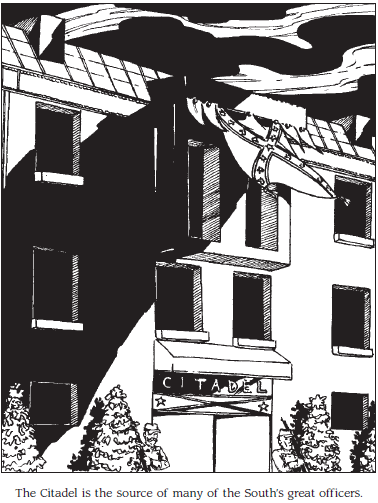
South Carolina, the Palmetto State
In comparison to the rich level of detail in places, folklore, monsters, and adventure hooks of North Carolina, South Carolina is positively lacking by comparison. The lion’s share of words are dedicated to the city of Charleston. Even the in-universe writer admits that he knows less about said state than the preceding one!
Overall South Carolina is a lowland country, with difficult-to-traverse marshlands nearer the coasts. The western regions hug the Appalachian Mountains and are the least-populated. The Confederate caste system is strongest here, and the aristocracy pretty much runs the place with the lower social classes having little influence in politics:
quote:
Below the aristocrats are the small farmers. Some of them make a good living, but they do not own as much land or control as much wealth as the planters. The “brown elite”—the mulatto children of interracial marriages—often belong to this class.
Lowest of all on the social ladder are tenant farmers, servants, and the like. Most blacks fall into this category. South Carolina was, in the years of slavery, one of the greatest slave-owning states. Having 300 or more slaves was considered the mark of true wealth, and even some free blacks owned slaves.
When slavery was abolished, a large class of freed, poor blacks was created overnight. Many have since managed to acquire farms, jobs in manufacturing concerns, or positions in the Confederate Army, and have prospered, but most still have a long way to go before they leave poverty behind.
 Antebellum Black Slave Owners
Antebellum Black Slave Owners While it is true that there were African-Americans who owned their own kind, this is a case of lying by omission. While there were doubtlessly some who exploited and profited from free labor (particularly light-skinned mixed-race ones who sought to ingratiate themselves into white society), many slaves owned by African-Americans were family members and friends purchased by their freed brethren but could not legally be granted manumission. The next best thing was that if they were legally owned by their parents, sisters, cousins, etc who were freedmen then this will prevent said family and social units from being broken apart. It should be noted that in contemporary times the “black slaver” claims are often misleading propagated by Lost Causer and reactionary types who seek to downplay the racism inherent in American slavery.
While it is true that there were African-Americans who owned their own kind, this is a case of lying by omission. While there were doubtlessly some who exploited and profited from free labor (particularly light-skinned mixed-race ones who sought to ingratiate themselves into white society), many slaves owned by African-Americans were family members and friends purchased by their freed brethren but could not legally be granted manumission. The next best thing was that if they were legally owned by their parents, sisters, cousins, etc who were freedmen then this will prevent said family and social units from being broken apart. It should be noted that in contemporary times the “black slaver” claims are often misleading propagated by Lost Causer and reactionary types who seek to downplay the racism inherent in American slavery.In addition to its strong caste system, South Carolina is also known as the Cradle of Secession for being the first state to declare its independence from the Union. It is also where the first shots of the Civil War were fired at Fort Sumter when the Union tried to resupply the soldiers there. The heaviest fighting in the battles that followed were around Charleston and across the coastline. Charleston suffered greatly during 1863 during a prolonged siege, where both sides used captured soldiers as human shields (the Epitaph only mentions the Union’s use) to prevent artillery fire from being used on the city or the invading army. Food was short and many starved, although by 1865 the removal of the blockade from Confederate reinforcements resulted in a Union route. Besides from bands of Yankees, Confederate deserters, and bandits in the 1870s, South Carolina has been more or less peaceful.
Now we cover Charleston itself, which is large and notable enough that many Confederates count it as the “South’s second capital.” And it certainly has its own culture: many doors from homes and buildings are painted blue from an old folk tradition which claims that the color wards off evil spirits. Like the rest of South Carolina, the Planter class rules the city and has weathered the siege best, and in spite of lean times find many occasions to host cotillions, horse races, and social events although they’re less happy-feeling now given recent grim times. The city is also home to a large amount of black freedmen, although in spite of the claim that “the only color most Confederates perceive in their Army being grey,” they still suffer their share of racism. Over the past half year a serial killer has been preying on the most wealthy of the black community, and the local police and politicians aren’t as concerned about pursuing leads as they ought to.
Wow, it’s almost like in spite of the post-racial claims of manumission and the default setting assumption, racism is still systemic and not just the province of individual villains!
But what the citizenry of Charleston regards as properly scandalous is some immoral cur who is preying off of the widows of aristocratic women who lost their husbands in war. After manipulating their grief and getting some wealth from their estates by disguising themselves as their miraculous “long-lost lover,” the figure vanishes with newfound wealth in tow.
Marshal’s Territory: The racist serial killers are a small group of pro-slavery advocates populated by Planters angry at the increased social welfare. Calling themselves the Guinea Captains after the sailors of old slave ships, they ambush, torture, and kill beloved African-Americans in the city. Charleston’s widows are being preyed on by a monster known as a Grieve, a shape-changing monster which derives sustenance from mortal misery.
Our section ends with a one-page description of some other South Carolinian cities, such as Georgetown which sits at the confluence of several rivers by the coast, or the capital of Columbia which holds an extensive prison camp of Union soldiers. The short life expectancies of said prisoners caused the warden to resort to dumping the bodies into mass graves...
Marshal’s Territory:...which is contributing to a growing zombie problem, who for now harass and eat farmers outside the city.
Thoughts So Far: This may be my personal bias, but this is my favorite chapter of the book. My home state of North Carolina is so far the coolest place in the South to have adventures: you got witches and monsters in the mountains, you got Blackbeard’s ghost menacing the high seas, you have folkloric monsters and ghosts animated by past injustices, you have ghost rock mines to feed your mad science devices and some Cherokee folkloric elements mixed in. But even that cannot save South Carolina’s Charleston-centric write-up, which just doesn’t compare at all to the Tarheel State.
Join us next time as we complete our tour with a round trip across Florida and the Deep South!
The Deep South
Original SA post
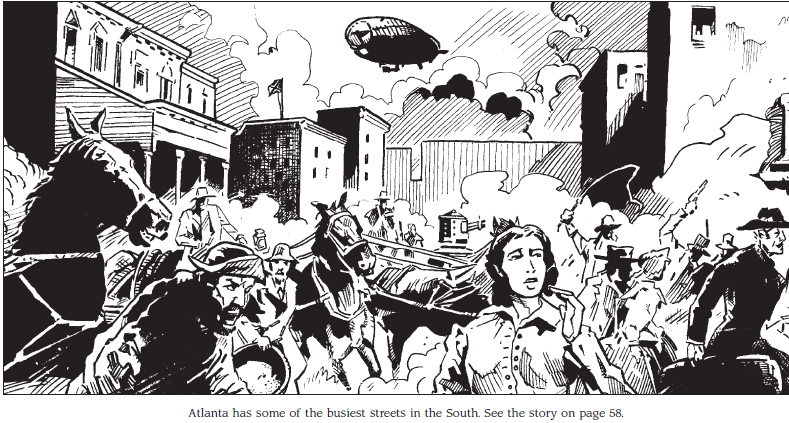
4. The Deep South
Our final regional chapter covers Florida along with a portion of the Southeast United States known as the Bible Belt. Although Louisiana and Texas are part of this region, as they’re west of the Mississippi they’ve been covered in other sourcebooks. So named for the strong bastion of socially conservative politics and a rather zealous interpretation of Christianity, this region is what most foreigners (and quite a few Americans) think of when they think about the South. The text also acknowledges this, in a rather wistful manner:
The True South posted:
Although Virginians may (or rather, are guaranteed to) boast and bray, the true heart of the Confederacy lies in the row of states from Mississippi to Georgia: the Deep South. In these nearly subtropical climates grow the magnolias and cotton fields that the world thinks of as quintessentially Southern. Barring Atlanta (and the new growth in central Alabama), the Deep South is rural and agricultural. It has the great preponderance of the fine plantations and the scrappily independent yeomen that together set the Southron character apart.
This Black Belt of agrarian wonder (so called because of the soil) seems almost torn from a past time. Whether that time is the antebellum days of prosperity (and slavery), the romantic England of Sir Walter Scott and King Arthur, or even the days of the forest primeval before human foot trod the sandy hills—well, maybe there’s something of all three in it.
Whatever it is, the romance, the fertility (or simply the heat and humidity), there’s something about the true South that nothing else can replace. And that’s coming from a proud Son of Erin, true enough. I owe Mr. Lincoln’s “Railsplitter” thugs some thanks for running me out of Chicago and letting me find the America I came looking for.
I like how the Epitaph writer’s painting a rosy picture, briefly delves into the legacy of human bondage, and then without missing a beat continues on the nostalgia trip.
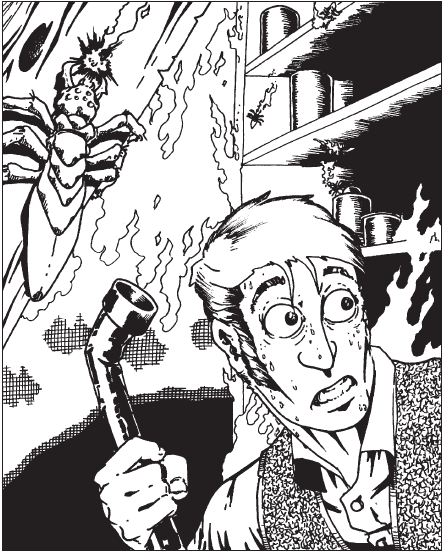
Mississippi, the Magnolia State
So named for the abundant white flowers which bloom on trees, Mississippi is a hot and wet state upon which the river’s mouth of the same name stretches across its western perimeter. Swamplands are common particularly in the Delta and Natchez regions. The capital of Jackson sits in the relative geographical center, and more traffic comes here by riverboat than rail. Northern Mississippi is heavily forested with farmland, and the university of Oxford is the major center of learning.
 Cotton Kings of the South
Cotton Kings of the South Cotton and other slave-harvested crops were so profitable in this region that the state was home to the highest number of individual millionaires in the country during the Antebellum period.
Cotton and other slave-harvested crops were so profitable in this region that the state was home to the highest number of individual millionaires in the country during the Antebellum period.In southern Mississippi there’s a group of pro-Unionists in Jones County. But another famed resident here is High John the Conqueror, an African-American dashing rogue dubbed the “Black Robin Hood.” His favorite targets include proud and haughty white men in positions of power, usually humiliating them in some non-lethal fashion although he is not averse to violence:
quote:
Sometimes he just puts the mojo on a traveler or he brings a gang of maroons to whale the tar out of some plantation foreman who’s too handy with the whip and needs to be reminded about Jubilee. Other times, he tricks his mark into a game of cards, some wild gambling scheme, or even more grandiose notions which always turn out to cost a pretty penny.
So even though African-Americans are supposedly equal and respected by the text’s author’s assessment, there’s still white supervisors who act like slavery’s never ended. Hmmm, I’m starting to see why the Planter class wasn’t as vicious in curtailing what social progress was supposedly being made.
And even though it’s most certainly not because the Confederacy sees any color other than grey, a high bounty is on High John’s head, and the Knights of the Golden Circle have an even higher one!
Marshal’s Territory: High John the Conqueror is a supernatural being of justice. He may be an aspect of Anansi, and has been called Br’er Rabbit for his ability to take the form of a large gray hare. High John has the ability to teleport any distance as long as a “child of Africa” is playing drums at his intended destination. He cannot be hurt or killed with mundane weapons, and there’s quite a number of black highwaymen who take up his name. He only intervenes in the latter case if they target innocents or cause collateral damage, seeking to not let wrongdoers exploit his name.
 Free State of Jones
Free State of Jones A group of people in Jones County, Mississippi led a guerilla military campaign against the Confederacy. Little is known about the motives and rationale of the rebels besides the fact that they declared their county the Free State of Jones and raided Confederate supply wagons to take back tax money and grain seized from residents. The microstate entered the public conscious when a 2016 period film was released for it.
A group of people in Jones County, Mississippi led a guerilla military campaign against the Confederacy. Little is known about the motives and rationale of the rebels besides the fact that they declared their county the Free State of Jones and raided Confederate supply wagons to take back tax money and grain seized from residents. The microstate entered the public conscious when a 2016 period film was released for it.The other two towns of note in Mississippi include Biloxi, which has good food but dangerous swamps where the black people are well-versed in voodoo and thus it’s dangerous to go out alone (yes really the book says this), and Beauvoir which sees high activity from the Nightwatchers due to the fact that President Davis is rumored to use the town as a private retreat.
Marshal’s Territory: A group of hucksters use Oxford for magical research studied in secret. The Knights of the Golden Circle are using alchemy to brew a facsimile of President Davis’ doppelganger (the irony is not lost on them) in hopes of installing a sympathetic puppet in the Confederate White House.
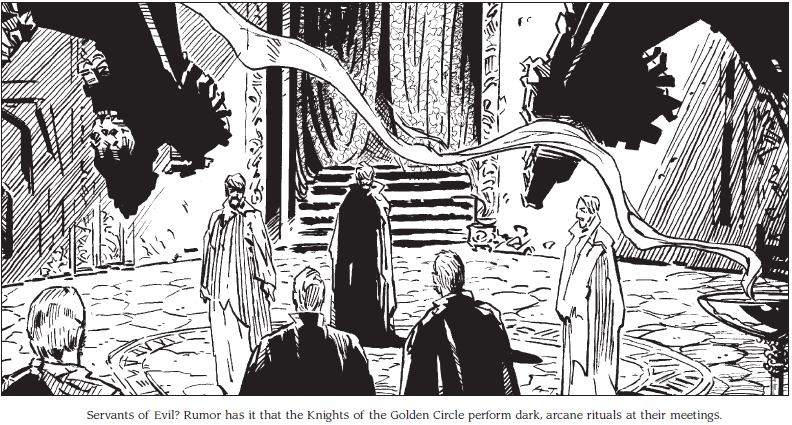
Alabama, the Heart of Dixie
Alabama is perhaps the most patriotic out of all the states of the Confederacy, and it’s a common joke that residents say that Montgomery’s the true capital and “Richmond’s just holding onto it for a while.” Some people figure that their gungho pro-war attitude is because they’re so far south of the front lines. The town of Mobile has a group of strange bluish-gray standing stones which even the Native Americans know nothing about, and some people claim to spot a literal ghost ship sailing up the Tombigbee River. Tuscaloosa and Moundville are foggy, weatherbeaten settlements where locals believe that European druids or a Lost Tribe of Israel once sailed to in ancient times. The capital city of Montgomery is perhaps the most “Western” of Confederate cities on account that some cattle and saloons with gambling are present.
The slave trade made many planters rich here, and an entire street is lined with their mansions. In fact, the most powerful group in the city is not the government, but a secret society pulling strings: the Knights of the Golden Circle.
Although mentioned earlier in prior chapters, we get a detailed write-up on this group here. Basically much like in real life they were formed in the 1850s as a reaction to the growing abolitionist sentiment. Looking south across the Gulf of Mexico, they proposed a separate nation of slave-states, encompassing a “golden circle” spanning conquered Central American nations, the US South, and Caribbean Island countries with Havana, Cuba as their capital. Inspired by the Freemasons they created their own members-only chapterhouses, secret symbols and handshakes, and loyalty oaths made by men willing to take up arms to realize this reality.
Naturally they were big supporters of the Confederacy, and ingratiated themselves into Davis’ cabinet. Once the war stretched on, the Knights reorganized into a council known as the Kuklos Khrysos: Greek for Golden Circle, and a nod to the real-world KKK’s “Kuklos Kuklos” fraternity motto from which they got their name. They even adopted esoteric titles such as the Imperial Grand Master, which more or less confirms that in Deadlands the Knights of the Golden Circle absorbed what would have become the country’s most notable white supremacist terrorist group. Beyond the Knights “owning Senators like they used to own slaves” and controlling the ghost rock trade in North Carolina, they are regular arms suppliers in Latin America, control most of Haiti’s economy, own many slave plantations in Brazil, and replaced and bought out every port official and provincial governor in the Caribbean that matters.
In fact, the Knights still have black slaves right here in the South! Selma, Alabama is one of their strongholds, a polluted industrial hell where the blood and sweat of black laborers work night and day. The workers are fenced in via barbed wire walls manned by gunmen and live in deplorable shacks and shanties. The factory owners who also operate cotton plantations claim that the walls are for their safety, but the rifles point inwards not out.
See, it’s a bit hard to swallow the post-racial nature of the Confederacy when a white supremacist organization is secretly dominating economic and social affairs on an international level. One other thing that does get me is that the Knights are willing to ally out of convenience with other evil groups in the setting, such as Baron LaCroix of Bayou Vermillion railroad. The last part makes no sense: LaCroix is a black, well-educated Haitian man of wealthy background and a practitioner of Vodou. Given that Haiti was formed due to a nationwide slave rebellion and Vodou was regarded as a “savage faith” by white slave-owners, LaCroix is literally everything the Knights stand against. Unless Bayou Vermilion is unaware of the Knights’ true nature and have the wool pulled over their eyes, I can’t see the Golden Circle making nice with him. But the “allies of convenience” statement makes it sound like they’re aware of each other’s existence. I also cannot view LaCroix feeling that his aid as something that will help his organization in the long run: other Deadlands sourcebooks note that the rail company has African-Americans in positions of power throughout its administration.
The last place of note to cover in Alabama includes the famed Montevallo College where even students from Europe attend, and one of its science professors is delving into the theories of electricity. Too bad for him, for the Mormons of Deseret already have a working electrical grid and tram cars in Salt Lake City.
Marshal’s Territory: A mad scientist is creating electric-powered machine-corpse hybrids from the bodies of prisoners of war in Camp Morgan. He currently uses them to rob gin mills and beat up the local loan shark he owes money to rather than practical military applications. Priorities!
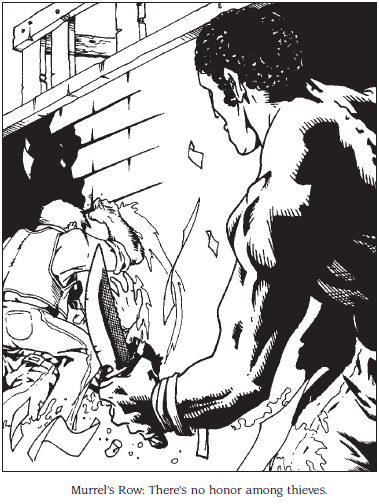
Georgia, Empire State of the South
The site of Sherman’s March to the Sea, it is a not uncommon sentiment that Georgia has fought and bled more for the Confederacy than any other state. In spite of that they are extremely independent to the point that the government places its state’s matters first at a level that would make its neighbors blush, much to the chagrin of the Davis Administration. The state is also the headquarters of the Confederate States Mint, and the capital of Atlanta is heavily industrialized with ironworks and sawmills galore. In fact, the heavy confluence of rail lines means that there’s a growing number of ghost rock-powered personal vehicles such as steam wagons and velocipedes owned by a growing number of residents. In fact, it’s one of the few cities in North America that’s experiencing the wonder of traffic jams several decades early!
Altanta’s bad part of town is Murrel’s Row, where all manner of lowlives ply illegal and semi-legal trades. In fact, the place is named after the bandit John Murell who back in the 1830s sought to start a slave rebellion against the Southern Aristocracy.
Marshal’s Territory: Murrel’s son is the most prominent crime boss of Atlanta. He is training a secret army of African-Americans in hidden swamp and coal tunnel hideouts to “liberate” Atlanta by razing the city and killing its Planter class. Along with the “liberate” word in quotes and describing his private army as indoctrinated, I’m getting flashbacks to Bioshock Infinite’s Vox Populi. Said group was made up of oppressed black and Irish laborers who were portrayed as “just as bad” as the white supremacist slavers they sought to overthrow. The fact that Bioshock made them anti-Christian and wanting to rape white women in the “your homes, your lives, your wives are ours!” didn’t do the narrative any favors. While Back East’s black revolutionaries aren’t as gauche as Bioshock’s, the whole black criminal/radical archetype feels downright unpleasant when you consider the fact that the book expects you to thwart their efforts to preserve...the Confederacy.
The other character of note in Atlanta is a John Wilkes Booth impersonator, who formed a Knights of the White Camellia chapterhouse in town. The charade did not live on for long, when it turned out that the man was a local reverend. A conspiracy theorist newspaper owner by the name of Yammerin’ Ned has pieced the truth together about the Reckoners, but his sensationalism and paranoia make most not take him seriously.
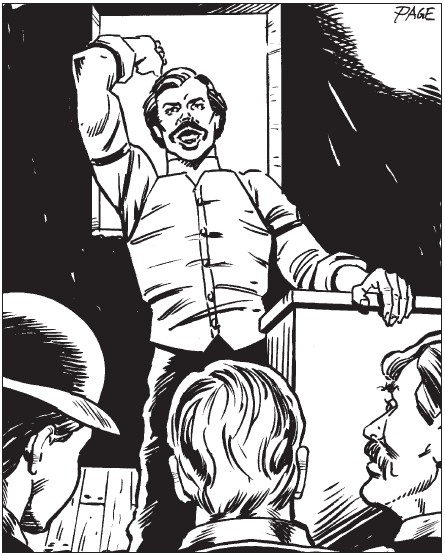
Marshal’s Territory: This John Wilkes Booth is the real deal. The Reckoners were mighty impressed at his brass balls and the fear he generated from assassinating Lincoln, so they returned him to life as a Harrowed. Now Booth is training a secret order of assassins among the White Camelia Knights to strike up into the North to sow fear and discord among the Union.
Our last stop in Georgia is the multicultural town of Savannah, home to many European and Jewish immigrants from various nations. The Tybee Island Amusement Park hosts minstrel shows which the book is quick to point out are “only with real Negroes, for the whole park is run by free blacks.”
 Minstrel Shows with Actual Black People
Minstrel Shows with Actual Black People Although the racist blackface plays were by far the most popular, there was a small amount of African-American performers who sought to popularize on the trend. Although said plays also delved into stereotypes, many of these actors sought to provide a more authentic and less propagandized look into their culture, sort of akin to how some Arab and Muslim actors today take on terrorist roles in Hollywood in the belief that they can mute the damage an outside actor would otherwise do in their role. For example, the common minstrel show trope of the scared, confused former slave happily reuniting with their old master was largely absent among plays with black actors.
Although the racist blackface plays were by far the most popular, there was a small amount of African-American performers who sought to popularize on the trend. Although said plays also delved into stereotypes, many of these actors sought to provide a more authentic and less propagandized look into their culture, sort of akin to how some Arab and Muslim actors today take on terrorist roles in Hollywood in the belief that they can mute the damage an outside actor would otherwise do in their role. For example, the common minstrel show trope of the scared, confused former slave happily reuniting with their old master was largely absent among plays with black actors.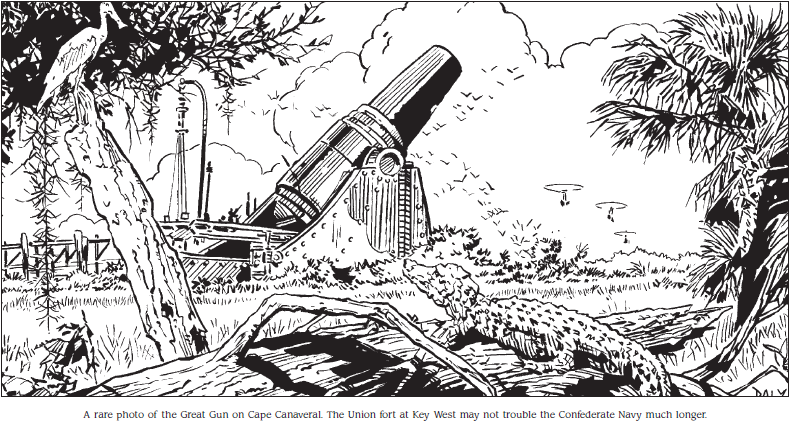
Florida, the Sunshine State
The author’s bias shows through when he talks about Florida. The entire state is on top of a giant limestone cave and tunnel system, but North Florida is described as a veritable paradise of great food and beautiful cities and landscape. South Florida on the other hand is “the section of Hell that Lucifer saves for people who divide Florida wrong,” a reference to the British dividing it by east and west. Florida’s south is full of mosquito-filled swamps and holds the Everglades.
St. Augustine is a creepy city which was burned down no less than three times over the course of its history, and every nook and cranny cannot help but give the feel that it once held a hidden body. The town has some of the largest rats, and its sewers go straight into underground limestone caves.
Speaking of which, Devil’s Den is an enormous limestone cave under a hot spring, while the Devil’s Millhopper is a gigantic sinkhole 120 feet deep and 500 feet across. It’s not uncommon for shifty land speculators to buy up land around sinkholes for literal pennies, then turn around and sell it as prime real estate to gullible buyers.
The Apalachicola Forest is a huge territory of pine, oak, and cypress woods which are mostly untracked. Locales speak of “Apalachicola Smoke” seemingly from natural geysers which confounded Union and Confederate troops alike who believed them to be military smoke signals. A secret base of Confederate aerial soldiers are somewhere near the town of Pensacola, and Tampa-Town is the chief importer of fine Cuban cigars the Southern Aristocracy loves to smoke.
Marshal’s Territory: St. Augustine's creepiness is due to a higher than usual number of ghosts. The giant rats are abominations known as ratkin who are conducting a subterranean war against the spiderkin who hunt and feed off of them in the sewers and caverns. The smoke in the Apalachicola Forest are actually secret signals used by moonshiners operating illegal distilleries. A skunk ape addicted to cigars hangs around the outskirts of Tampa-Town to steal its favorite vice.
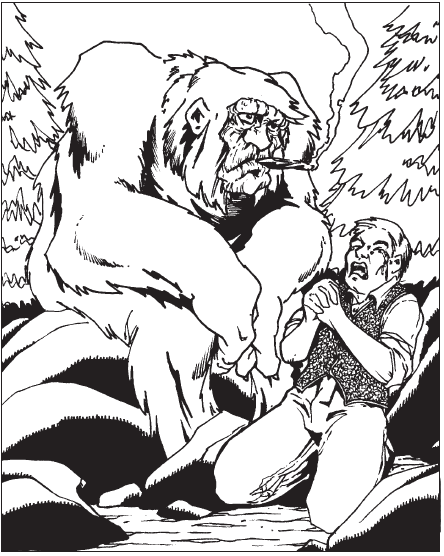
This is my favorite picture in the entire book.
The Union military has a presence on the island of Key West in a veritable naval fortress. The North claimed it near the beginning of the Civil War, recognizing its strategic value in the Gulf of Mexico. But in response, the Confederate war department is working on a Great Gun Project at Cape Canaveral, a gigantic cannon hundreds of feet long. Its ghost-rock powered design is theoretically capable of shooting Key West from 400 miles away, and can be aimed in any direction.
The Everglades cover a third of of Florida, a veritable lush expanse of dangerous marshland crawling with all sorts of life with alligators being the most well-known. The ever-changing grass sea makes map-making useless, and the Seminole Indians live here. No stranger to fighting, they still strike out at Confederate fortresses from time to time. Most white people who live in the Everglades are creepy inbred families who teem with physical and mental deformities.
Errrrr...wait, are we going to end on that politically incorrect description? Hold on a second-
A Fond Farewell to Dixie!
Oh God, we are. The Tombstone Epitaph finishes its in-character write-up here, hoping that we as readers enjoyed this little trip through the heart of the Confederacy, and that we use the knowledge provided to keep us safe from the dark forces menacing the South.
Marshal’s Territory: The Great Gun Project is being sabotaged by the Reckoners to not only be able to shoot up to 1,500 miles, but will only be effective against devastating civilian population centers and not troop movements. Finally, many of the Seminole Remnant forces have turned to voodoo black magic to better fight the Confederacy.
Thoughts So Far: Although thematically appropriate given that the region was a veritable stronghold of white supremacy, the Knights of the Golden Circle and High John the Conqueror show cracks in the foundations of the supposed progressivism of the Confederacy. I do like the idea of a folkloric hero such as High John showing up, but he’s far too good to be in a book such as this.
Although Deadlands always had a bit of a steampunk vibe, the traffic jams of Atlanta and the super long range cannon of the Great Gun Project feel a bit too advanced on account that even the steampunk Mormons do not have an equivalent weapon in the latter case. Hellstromme’s ghost rock bombs come the closest, but they have to be dropped via airship rather than a missile which can shoot targets several states away.
As a villainous organization, the Knights of the Golden Circle can be a good antagonistic faction in theory, but like High John's existence is odds with the suddenly magnanimous nature of Confederates who “saw the light to manumission.” They are too prominent, too powerful, and embedded power structure cannot result in anything but systemic racism rather than the individualized bigotries Deadlands wishes to promote. You can’t have white supremacists control every Caribbean port and the ghost rock trade in an entire State and somehow be brushed off as “a few bad apples.”
Join us next time as we cover new player and GM-specific rules, options and monsters in the Southern Soldier and the True South!
The Southern Soldier & Marshal’s Territory
Original SA post
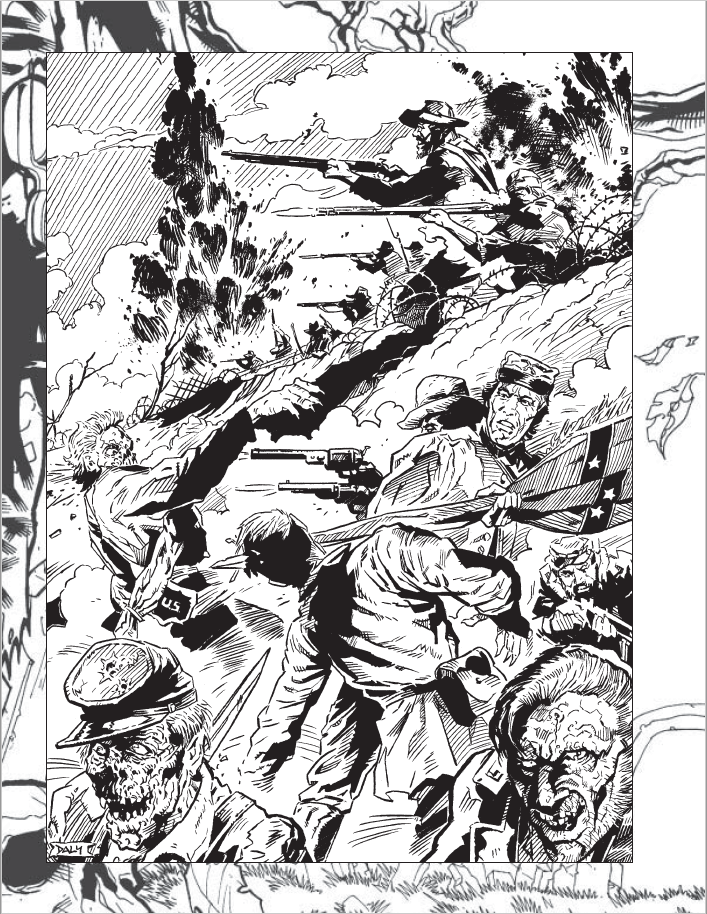
5. The Southern Soldier & Marshal’s Territory
The Southern Soldier is all about player options. It has new Edges, Hindrances, pregenerated PCs, and role-playing notes.
We open up with a mention that 1/3rd of the Confederacy’s male population served in the army, and as those 16 long years went on along with the horrors of the Reckoning this has made the South a hardy people.
New Edges are specific to those who grew up the South or come from a culturally-similar region, and a lot of them focus around endurance in the face of hardship. Cavalier represents how many rural Southerners are accustomed to riding horses and suffer no penalty on ranged attacks while mounted. Foot Cavalry adds bonuses to Vigor rolls for long marches, Forbearance ignores levels of starvation penalties equal to the Edge’s rank, and Seen the Elephant does the same as the last but for non-supernatural fear-related effects. Gallows Humor and Rebel Yell are social-oriented edges, the former substituting Ridicule rolls for Guts rolls vs. fear, while the latter does an AoE fear-based debuff.
There’s only two New Hindrances: Honorable is exclusive to members of the Southern Aristocracy, and is particularly debilitating to women in spite of being priced the same. Both genders must refrain from lying, cheating, stealing, and being rude in social situations. Men must be ready and willing to avenge slights against his own honor or that of his family’s as well as that of any women, while women must stay at home and cannot go off adventuring or working a job unless they’re a widow with no father. Failing to uphold your honorable nature causes social censure, and most Southerners of all social classes will refuse to associate with you. The second Hindrance, Impulsive, is exactly what it says on the tin and encourages your character to act without thinking and unable to effectively formulate plans and long-term ideas.
Shootin’ Irons: Our two new guns include the MK I Snider-Enfield and the Martini-Henry Rifles. Both are breech loading mechanisms which are standard units for Confederate soldiers, the latter being of British origin. As the South lacks the industry of its Northern adversaries the arms and ammunition are imported from their British allies. In fact, the Winchester Repeating Rifle is superior to the Martini-Henry, and it’s not uncommon for Confederate soldiers to loot such weapons off of Union soldiers when the opportunity presents itself.
 Confederate Sniper Rifles
Confederate Sniper Rifles It’s strange that the real-world Whitworth Rifle is not included here. I even checked the Deadlands 20th Anniversary Edition book to see if it was already part of the Classic core rules, but it’s not there either. Said weapon is credited as the world’s first sniper rifle, used extensively by Confederate sharpshooters, and was extremely accurate even when compared to guns of Union and European make.
It’s strange that the real-world Whitworth Rifle is not included here. I even checked the Deadlands 20th Anniversary Edition book to see if it was already part of the Classic core rules, but it’s not there either. Said weapon is credited as the world’s first sniper rifle, used extensively by Confederate sharpshooters, and was extremely accurate even when compared to guns of Union and European make.Pregenerated PCs: One of the more novel things the Deadlands game line does is create pregenerated PCs in just about every major sourcebook of theirs. They are in line with the book’s themes and culture, and for Back East: the South we have three of them: the Blockade Runner, a charismatic ocean-bound warrior equally skilled with a shootin’ iron or sabre in their hands; a Discharged Veteran who is an honorable one-armed pistoleer; and the War Widow, a soft-spoken woman who is less combat-focused than the first two and is geared more to social and “streetwise” skills.
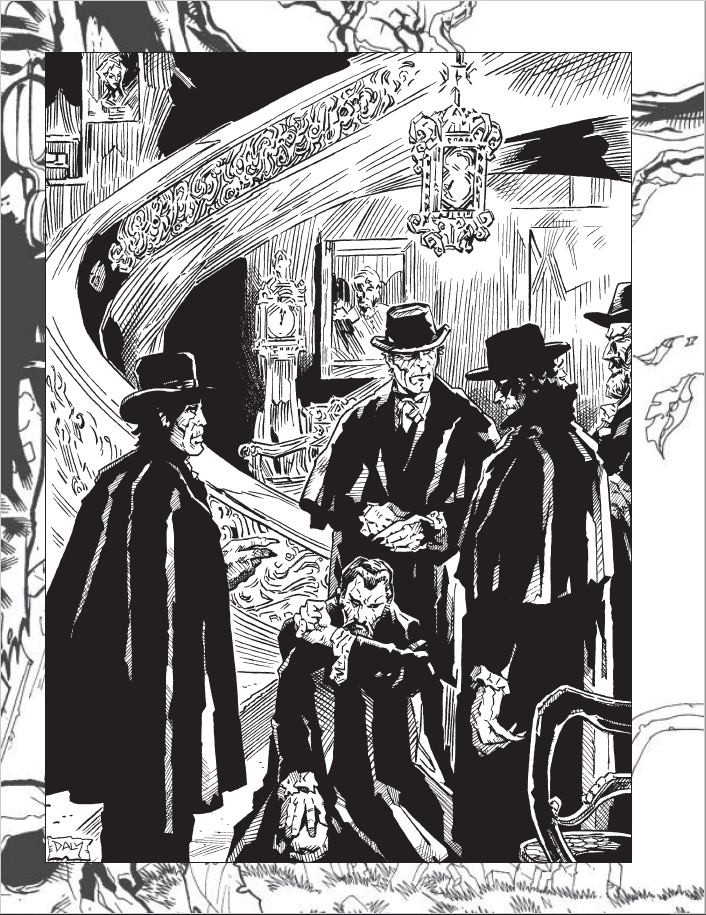
The True South
This final chapter’s going to be rather short. The reason is that the bulk of the GM-facing Marshal’s Territory plot elements and secrets I folded into the prior chapters. Which just leaves us some general mood-setting notes for GMs along with new monsters. We get some brief write-ups particularly useful to the creation of monsters, being in the Southern Gothic tone. Basically the Confederacy, and by extension the Union, are less lawless and more settled than the Western frontier. Abominations such as gargantuan Rattler worms and Texas Tummy Twister giant insects are dismissed as tall tales. Instead, the Reckoners play upon the cultural and religious fears of Southerners, fashioning their monsters out of human folly like Jefferson Davis’ doppelganger. Many Southerners are quick to attribute Divine Intervention for supernatural happenings rather than Weird Science or cryptozoology.
But we also get some...gems I have to quote here.
Role-Playing the Rebels posted:
The Posse Territory is written from decidedly pro-Southern points of view, but this wasn’t done merely to infuriate readers north of the Mason-Dixon Line. Rather, it’s to give the Marshal an idea of how Confederates view themselves, their culture and history.
In Real Life, we’re not advocating any particular point of view, but Southern-born characters in your game should, at least to some extent. If they’re role-played differently than Yankee-born, Western-born or Indianborn characters, they are more than just consistent with the material in this book, they’re more fun to portray.
Whistles in Dixie
Race & Gender in the New South posted:
Except for isolated examples such as the Knights of the Golden Circle, racism is becoming a thing of the past in America. In Deadlands, the Confederacy resembles the United States during World War II: some progress has been made towards equality, and more will come after peace returns and people resume their normal lives. Further integration of Confederate society has yet to become a concern, but when it does, blacks and whites will approach it with a greater sense of community and shared values than in actual history
Ah, WW2 America, that bastion of progress, peace, and racial harmony.
The Knights of the Golden Circle; so isolated they can control the reigns of Confederate economy and government from behind the scenes.
quote:
Women have begun breaking out of the Southern Belle mold. Necessity made it socially acceptable for unmarried women to pursue most vocations, so long as they fulfill their class’ other expectations. Only women who openly defy their husbands and fathers, fail to provide for their children or otherwise lack virtue are ostracized. A few women have grown unconcerned with such stigma in any event.
Much like the sheltered Victorian housewife trope, the Southern Belle ideal of well-dressed idle ladies untouched by the drudgery of labor is a myth for all but the upper class. American women, particularly the working class, had to work and contribute to feed their families and not just in housework. In the cities they worked in textile factories, and in rural communities they farmed and ranched alongside their husbands, brothers, and fathers.
quote:
The bottom line is: if you’re portraying all (or even most) Southerners as racist, sexist rednecks, or as minstrel show cast-offs, you’re robbing your posse of the enjoyment of interacting with truly well-rounded characters. If you save the truly bigoted characterizations for abominations and Fearmongers, your posse will derive more enjoyment from defeating them.
This is a bit of a false equivalency. I can understand apprehension of some Americans when the South is singled out as some unique bastion of racism, particularly when said Americans then go on to presume their own cultural regions are somehow free of prejudice. But unironic portrayal of minstrel show stereotypes are...well, worse. A lot worse.
Heck, Deadlands isn’t exactly innocent in the realm of redneck stereotypes either besides the aforementioned incestuous swamp people: one of the sample villainous groups in Grim Prairie Trails are the Squatpump Gang, a group of inbred rednecks stupid to the point of mental disability, so filthy that their outhouse forces a Fear check on anyone who opens the door, and their kitchen’s stovepipe stops short of the ceiling causing the entire room to fill with choking smoke whenever they cook a meal. And they’re played for comic relief.
This may be small potatoes, on account that said books were published over a decade between each other and have different writers, but it feels odd that they can be consistent on one problematic trope (non-racist Confederacy) between different writers and their metaplot, but not this.
Abominations of the Confederacy
We have seven monsters detailed here.
Ghosts are perhaps one of the most well-known monsters, if not directly than by folklore. They are incorporeal beings cursed to remain in the mortal world, immune to most physical attacks, and can appear as a variety of spectral forms from the typical transparent grey to a rotting corpse with blood and guts hanging from their levitating bodies. They have a “chill touch” which can deal damage to a struck target, and we have a detailed list of what spells can effect them normally.
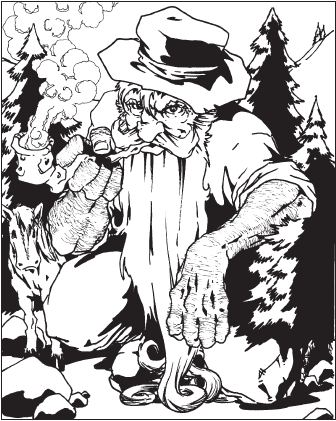
Giants of Appalachia are very rare and typically do not encounter humans save when the latter group goes out searching for them or if some fertile unspoiled territory of the giant’s is ripe for farmland or railroad tracks. The book advises keeping them away from “civilized” areas on account of the more subtle horrors of the South. As you can imagine they are physical powerhouses but not very smart.
Old Fire Dragaman is like his brethren, but taller, stronger, and can breath out fire as a breath weapon.
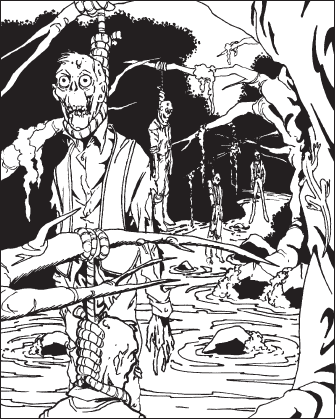
Hangmen are the reanimated corpses of people whose bodies were lynched and left to rot, their eyes bulging and heads lolling off to an unnatural angle. Hangmen are immune to normal damage, and can use their own ropes to strangle targets. The only way of killing one for good is to tie and force its rope-weapon around its neck in a wrestling hand-to-hand combat task.
Slave Warders are the Reckoner-created distilled fears of the horrors of chattel slavery, and look like fugitive slave hunters of old but with wild crazed expressions and behaviors. They manifest in plantation houses, slave pens, and other areas filled with the ambient energy of black suffering, and wield lashes and chains as weapons.
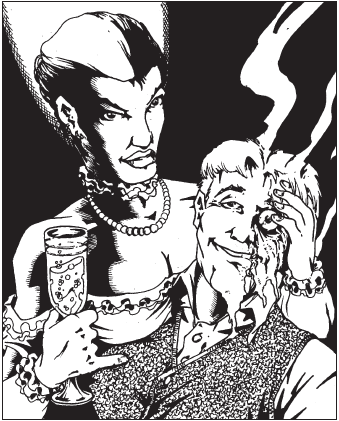
Succubi are exactly as you imagine them to be, and a particularly virulent specimen is making the rounds in Nashville’s red light district. She has large bonuses on persuasion rolls where her sex appeal is a factor, can spend fate chips to impose penalties on men who try to resist her charms, and can inflict a deadly melting attack on those who embrace or otherwise become physically intimate with her.
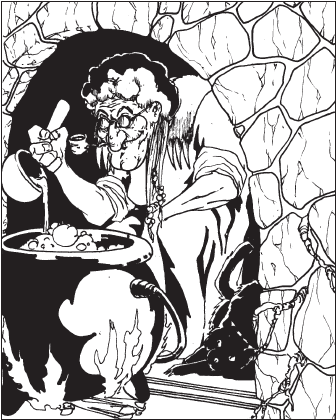
Appalachian Witches can be men, but the overwhelming majority are women who are either young and beautiful or old and ugly. Apparently middle-aged witches lose their powers or something. They usually either live by themselves in cabins or gather in coven witch-gangs of up to 13 members. They hold their rites in abandoned buildings, caves, and other places where they typically won’t be disturbed, and are not above using their magic to make certain areas seem haunted to later turn into a base of operations. They are immune to most forms of damage save for material made out of silver which can also be used to break their spells, and invoking the Lord’s name in their presence makes their magic less effective against the utterer.
Statblockwise they are black mages who can have whatever spells make sense but prefer subtle ones. They also have some unique abilities such as the ability to blight acres of crops, cause droughts or storms in a 5 mile radius, and shapechange into one specific type of animal.
Thoughts So Far: I’m not really a deep reader of Classic mechanics; I far too much prefer the Savage World rules so I cannot give a truly in-depth read of the rules therein. But the player-facing options felt too sparse and brief for my liking, and the Edges and pregenerated PCs presented did not feel sufficiently unique to the South besides the Blockade Runner that they couldn’t be used elsewhere in the setting.
For the GM-facing material, I loved the monsters the most. The Appalachian witch was positively brimming with folkloric mechanics which I liked the touch of. The ghost felt too generic, and the hangmen and slave warders were clear references to the horrors of Southern racism even if the Hangman do not specify the racialized history of lynching in their write-up. I can understand the inclusion of the latter choices, but it feels odd on account that the book tries so hard to make everything seem hunky-dory in regards to race relations. While I can understand a “keep racism confined to the villains” for general RPG advice, the presence of the more human, more prominent Knights of the Golden Circle makes “lynching/slave hunter monsters” feel weak when there are already influential humans doing similar wider-reaching evils.
Concluding Thoughts: Back East: the South is all over the place. There’s an uneven level of detail to the various regions and states, and even by the standards of Neo-Confederate propaganda the world-building’s poor enough that any serious examination of the Confederacy’s policies and racial attitudes doesn’t hold up to scrutiny. It is understandable to want to avoid period-era racism, but its systemic institutions are still present. Be it Charleston cops turning a blind eye to hate crimes, the Reckoner-backed Knights who still have slavery in all but name in Selma, or High John the vigilante punishing white overseers whipping black farmers who are supposed to be free. But most notable of all is the seeming assimilation of black Southerners to the point that discussions of their culture and folklore is overall absent besides High John and mentions of voodoo here and there. Compare this to the white Southern fluff like the Honorable hindrance or Appalachia’s rural mages. We hear about a doctor using miracles to bring Robert E. Lee back from the grave, but nothing about African Methodist Episcopal preachers acting as Blessed beacons against the darkness of the Reckoning. We hear about the black Confederate soldiers defying the Planter class by voting against a return to slavery, but nothing about the Underground Railroad network who was bringing their their people out of bondage years before much less where these unsung heroes are now in the Weird West.
It is perhaps Back East’s fumbled handling of race that is Deadlands’ greatest fault, which cannot save the rest of the work. Although written in 1999 the sentiments have carried on throughout the game line, and has been the greatest barrier against bringing new players and customers into this great gonzo setting of gunslingers and hexslingers. Much like the real world’s South, the beauty of Deadlands does not need to tie itself to the Confederacy to survive, and we can achieve so much more once we cast down the Stars & Bars.
Let us hope that Matthew Cutter’s desire of an inclusive setting, and Kenneth Hite’s willingness to confront the bigotries of Dixieland, carry forth into the new Deadlands to be released in 2019.
Mutants & Masterminds: Wars for Freedom
Original SA post
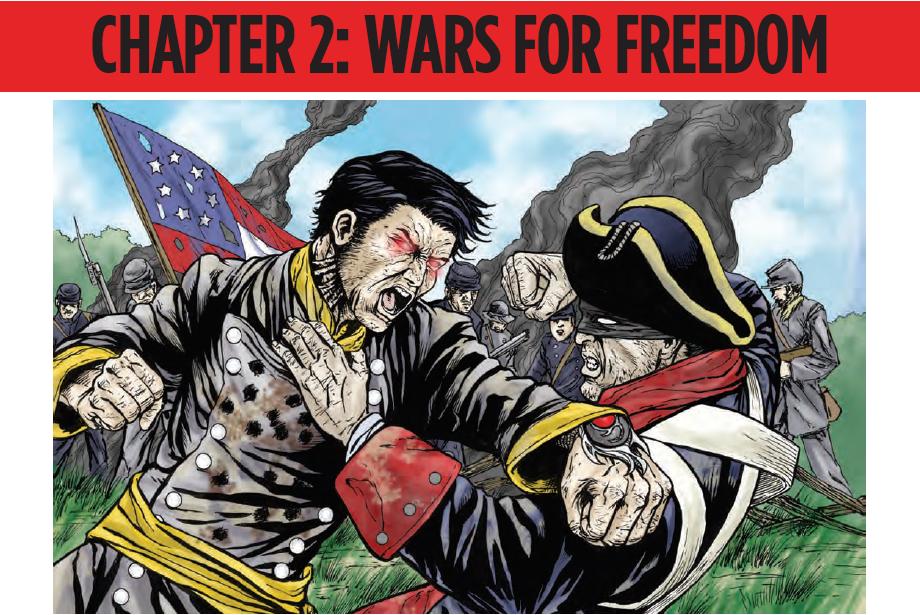
6. Mutants & Masterminds: Wars for Freedom
You might notice that this picture has a different art style, and that’s no coincidence. This is a snapshot from another book by another publisher for another game line: Worlds of Freedom for Mutants & Masterminds. The general idea for said sourcebook is adapting the “omniverse” concept of superhero comics to handle parallel Earths, different time periods, and dimensions along with sample chapters for the default Freedomverse setting for Mutants & Masterminds. Wars for Freedom details advice, tropes, and sample superhero teams for games set during the American Revolution and American Civil War.
Said chapter is also written by Christopher McGlothlin, the same Neo-Confederate author who helped write Back East: the South. Although I owned this book back in 2007, reading the Deadlands product reminded me of this. I figured that it’s a worthy inclusion of the same ideological mindset and authorial bias, but in a different game line.
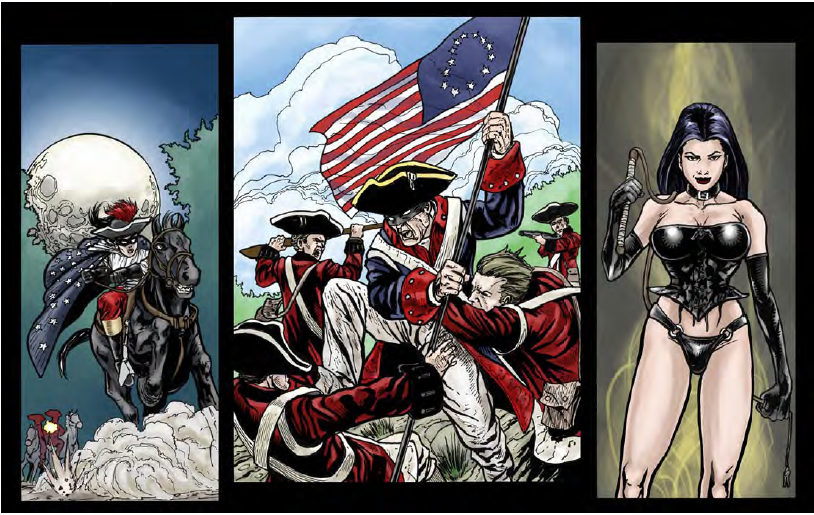
Freedom Fighters
Freedom City had a humble beginning as a British colony on the East Coast. Like many other colonists angry at British rule, the city lent its support to the Revolution. The British Navy began a brutal occupation of the city, but were eventually beaten back in 1779 by many brave souls and 3 ur-superheroes.
Major Joseph Clark was the son of an indentured servant who learned how to fight from the neighboring Happanuk Indians. He took his knowledge of guerilla tactics into organizing the Freedom militia into skilled, brave warriors. During the Revolution he went on to perform many great deeds, and his routing of a hundred Hessian mercenaries with only a dozen soldiers is something every schoolchild of Freedom City learns early on in history class. After the war Major Clark retired to a quiet life on a farm, appearing in public only once during the War of 1812 to wish the troops Godspeed, and died in his sleep on the 4th of July.
Lady Liberty I: A bit of Freedom City metaplot: the Spirit of Liberty is an entity which represents the idealized form of US values, what the country’s people could be rather than what they are at the moment. Life, liberty, the pursuit of happiness, and all that good stuff. The entity passes on its powers to mortals it feels can best make use of them, and as such the Lady Liberty title has been a multi-generational legacy.
The original Lady Liberty was a woman by the name of Elizabeth Forester who donned a red, white, and blue costume and domino mask to conceal her identity when fighting British soldiers. In fact, her husband’s execution from a mock show trial by British port authorities set her on the path to a more fair and just world. She became a steadfast companion of Major Joseph Clark, but grief over her late husband prevented their relationship from progressing into anything other than platonic.
Minuteman I: The first Minuteman was Captain Isaiah Hawthorne of the Continental Army, who gained the powers of super-strength after saving Happanuks from a massacre by colonists. To reward his deeds, the tribe gave him a rare manaka root plant to eat. With superhuman strength, speed, and endurance he proved a valuable asset in the war, as long as he had a dose of manaka to power himself up. He wore a costume to avoid being identified and thus compromising the secret, and his frequent absences during his Minuteman intervals put his normal career perilously close to a court-martial.
The Viscountess: Lady Samantha, the Sixth Viscountess Savory of Sudbury, is our sole villain for the American Revolution era. She’s basically an evil non-powered Wonder Women: she’s into S&M, uses a whip as her primary weapon, and heavily relies on seduction and blackmail to get what she wants. Her archenemy was Joseph Clark, who earned her undying enmity as one of the few men who wouldn’t sleep with her. After the American Revolution she began to fall from grace: some say she ended up in a loveless marriage and raised 3 daughters to follow in her footsteps, others say she eventually ended up in an asylum for “the ailments of Venus,” which was a real-world made-up mental illness for women who expressed an interest in sex.
Statwise the four characters above are Power Levels 5 to 6, which in Mutants & Masterminds terms means they’re “peak human” levels of power: a SWAT Officer is PL 6, a typical gangster PL 3, and the default superhuman PL 10. Only the Minuteman has an actual superpower, with the other three Badass Normals specializing in being well-skilled with a variety of mundane abilities and knowledge.
The Late Unpleasantness
Let’s face it guys and gals, this is the one you’ve all been waiting for, the section covering the American Civil War! It has a lot more content with two full-fledged superhero teams. At this point in history we get the lowdown on 1860s Freedom City: the place was an abolitionist stronghold with slavery banned within its environs. But when the Civil War broke out half the populace was divided because a lot of these otherwise abolitionist types wondered what right they had to “kill the Southerners who democratically voted to leave it.” The federal government’s broken promises to bolster Freedom’s economy and dredge the silting Centery Narrows made many citizens angry enough to join the Confederacy.
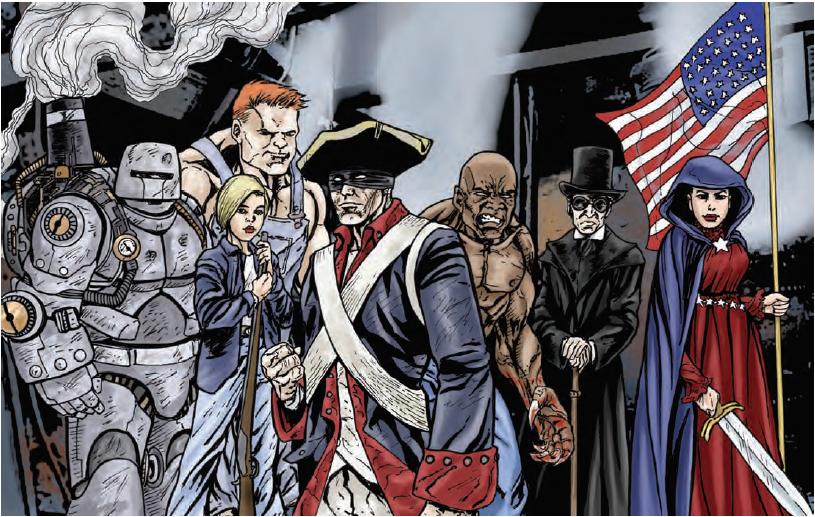
The Patriot Regiment
The remainder of this chapter focuses on two superteams, known contemporarily as “mystery men” for their strange powers. The Patriot Regiment fought for the Union, formed by Abraham Lincoln himself, securing many important Northern victories against all manner of menaces in and out of Rebel uniform.
Minuteman II: The superpowers from the manaka roots were heritable in nature, and passed on down the bloodline to Joseph Hawthorne. The powers manifested as super-speed as well as a preternatural “sixth sense” which helped him predict events in the near-future. Although he answered the fall of duty, the chaos and bloodshed of war tortured him with scenario after scenario of his friends’ and comrades’ inevitable deaths. He was discharged from his unit for mental trauma, only to become a masked mystery man in the new Patriot Regiment by donning the garb of his great-grandfather as an icon of the Revolution. The assassination of Abraham Lincoln was the final straw for him. Able to see it but unable to prevent it, he burned his costume and took the secret of his legacy to the grave.
Goliath: Incredibly strong but with the mind of a child, Columbia saved this unknown man from a lynch mob for an “unspeakable crime.” His sheer might was put to use in the Patriot Regiment, but he was a loose cannon who distrusted all of the others, at times expressing wildly swinging moods with childlike temper tantrums. He came to an end during the siege of Richmond, when Columbia discovered him in “the commission of an unspeakable act” which I presume to be either rape or killing children. She regretfully snapped his neck, even as he begged for forgiveness.
The Ironclad: This three foot tall man would be a villainous mad scientist in another time and place, but his sheer arrogance and prejudice against the unenlightened Confederacy drove him to join the Patriot Regiment to show onlookers the wonders of SCIENCE. His custom steam-powered warsuit let him participate in battle, and it was common for many people to assume that there was an unnamed test pilot in there. Most people were unable to believe that such a short person could be a great soldier. His post-war fate is unknown, beyond traveling west for new research projects.
Pathfinder: Steven Mullray inherited a superpower which made all five of his senses more powerful than the normal human limits, and such stimuli made his life one of toil. He personally believed that this was divine retribution for his ancestor’s sins, so he became an Abolitionist and Underground Railroad conductor as a means of repentance. Even more so when he heard the horror stories from escaped slaves themselves. He finally joined the Patriot Regiment after the Emancipation Proclamation was passed, previously viewing Lincoln as too soft on the Peculiar Institution. After the war he fought against the KKK and violent racists during the Reconstruction Era, but over the years his condition worsened to the point that he committed suicide to free himself from the overwhelming stimuli.
The Sharpshooter: Nicole Winchester’s husband died during the Battle of Manassas, putting her on the path to vengeance. She disguised herself as a man to join the Union Army, becoming the most feared sharpshooter in her unit. She was eventually court-martialed for letting her vendetta against all Confederates get in the way of good judgment, but her talents did not go unnoticed and soon was recruited into the Patriot Regiment. Also a mistress of disguise, she carried out orders without fail as long as they involved killing a Rebel soldier. After the war she left her team without saying goodbye, heading down South armed with but just a rifle.
Lion-Man: The Patriot Regiment’s token angry black man, Daniel was a slave in Missouri whose powers manifested after being tortured by his master. After killing him and heading North to freedom via Pathfinder’s aid, he joined the Liberators. This super-team of African-Americans were formed by Frederick Douglass to kill slavers and free their brethren in bondage. Daniel was highly skilled, but his bloodlust creeped out his other team members who “wanted to set a less threatening example.”
Errr...come on guys, you’re armed black people with superpowers killing slave-owners. Your mere existence is threatening to the dominant power structure as is!
When Abraham Lincoln recruited the Liberators for the war, Daniel felt singled out for some reason and joined Pathfinder in the Patriot Regiment. He became the teammate willing to do the dirtiest work:
quote:
Daniel coolly accepted inhumanity as a part of life, having known little else, and he carried out the often horrific duties of war without flinching. He was reliable under the toughest of circumstances, and in wartime, there’s no better thing to be.
He was a trusted member, if not necessarily a likeable person. After war’s end he disappeared much like Sharpshooter, heading off to find more battles to fight.
So if you haven’t noticed, just about every team member of the Patriot Regiment is basically an anti-hero, Pathfinder excepted. Now how do they compare to the Confederate super-team I wonder?

Knights of the Confederacy
quote:
Though outnumbered by the Patriot Regiment, the Liberators, and other mystery men fighting for the Union, the Knights of the Confederacy were able to stave off their country’s defeat for four long years. Courage and cunning were the team’s greatest assets, and they served the Knights well in their shadowy war with the Union’s super-agents. Though theirs was ultimately a Lost Cause, the Knights proved that glory, honor, and valor are not exclusively the victor’s province.
I thought as much.
Achilles: Achilles was found stumbling naked in the woods of Tennessee without knowledge of his origins, and grew up contented on a farm. He joined the Confederate army, impressing many as he single-handedly took on legions of Union soldiers, immune to bullets. This deed caused him to join the Knights of the Confederacy, dubbed Achilles for his seeming invulnerability. He’s also the first character here who is a non-conflicted, non-bloodthirsty good guy:
quote:
Powerful as he was, his most remarkable traits were his innate goodness and sense of mercy, even in a time of war.
His virtue faltered only once, when Lee’s surrender at Appomattox and the atrocities of Sherman’s March pushed him over the edge. Michael resolved to throw himself into the blue ranks just as he’d done at the war’s beginning, only this time he’d drown the Yankee soldiers in their own blood. Before he could do so, however, Michael disappeared. Not long after that, some strangely clothed visitors told his friends “Mik-El” was one of them, lost in the outside world, and that he was now home among his people, leaving behind only a legend.
Fun Fact: Achilles’ dubious origins spawned a minor number of fan theories, as well as a minor flame war on the Green Ronin forums regarding the presumption that he was actually an angel in an earlier draft, thus meaning that God in the setting took the side of slavers.
The Fouke Monster: A member of the rare skunk apes, the existence of said creatures became fact when one of them was saved from frightened Union soldiers near the town of Fouke. Grateful to the Knights which rescued him but only able to express this in grunts, his mystical powers to teleport between swamps for speedy getaways was a great boon to the team. He was abandoned by war’s end, and with a single tear for his absent friends he returned to his marshy homeland.
The Mermaid: Found adrift at sea as a baby, Varina Beaulieu was actually a member of the undersea race of Atlanteans. She did not find out about her true nature, so she joined the Confederate Army to find a sense of purpose in sabotaging Yankee vessels with water-controlling powers. She began a romance with a Confederate sailor who later drowned on the CSS Hunley in spite of her best efforts. She became heartbroken, and later met an end in the fires of her homes during the destruction of Charleston in 1865.
The Night Stalker: Thomas Pembroke was a Virginian aristocrat who made his fortune in slaves and was darling of the Richmond social scene. He became seduced by a vampire and cursed with undeath. His own personal scruples made him drink only the blood of the wicked, becoming a vigilante in the state capital known as the Night Stalker. He joined the Knights at Achilles’ behest, the two becoming fast friends in spite of many disagreements.
quote:
Only Achilles truly understood Thomas’s endless battle against his dark side, and he carried out his wishes when he ultimately lost it. After the fall of Richmond in 1865, Achilles found Thomas feral and blood-drenched in the ruins of his plantation, and he tearfully beheaded his friend, freeing him from his curse in the only way possible.
Awww, that poor rich well-off man who made a fortune off of systemic degradation and torture. If only his own vampirism did not drive him to the dark side in killing all of the slaves he previously treated like subhuman property.

Nunnehii: The Cherokee man Yartunnah Watie gave up his cultural traditions to please the white man, and all he had to show for it was being forced off his homeland during the Trail of Tears. Old and broken, his faith in human nature was restored when benevolent spirits of legend known as the nunnehii spoke to him. When his tribe sided with the Confederacy who treated his people honorably, this event was enough motivation to find something worth fighting for. He eventually came to serve in the Knights of the Confederacy, using summoned spirits to great advantage and being called the name of said spirits by others. After the war he used his spirits for the betterment of his tribe, only to be shot by a Union officer scared of “some crazy old Indian preaching mumbo-jumbo.” And so Yartunnah joined his companions, the nunnehii, as his final dying request.
The Ranger: Charles Napier was a Texas Ranger par excellence. Ahead of his time, he used more modern investigation methods to solve crimes as well as guns and fists. He gained the powers of super-speed from a nearby glowing meteor, and donned a costume to use his powers for good while also avoiding the social stigma of being branded a freak. He joined the Knights of the Confederacy due to a sense of duty to Texas who sided with them, and he used both his costumed and civilian identity to great effect. He lost the use of his powers during the final days of the War, where he tripped and broke both legs at super-speed. However, he managed to live a long and happy life post-war, raising eleven children inspired by tales of a Ranger who could outrace the wind.
So basically, every Confederate Knight is a traditional hero save the tortured soul of the Night Stalker. Even the Fouke Monster’s “uncivilized brute” status is mostly good-natured in comparison to Goliath who may be a potential rapist/baby-killer. Half of the Patriot Regiment’s team ends either in tragedy or unknown fates, while the Ranger’s the only one who gets a true happy ending.
Divided Liberties: Although both sides are part of the respective mystery men super-teams, Lady Liberty’s second incarnation gets a special sidebar. Due to the Union and Confederacy’s differing ideals regarding freedom, there were two Lady Liberties instead of one. I could surmise it, but I felt that the half-page sidebar speaks for itself:
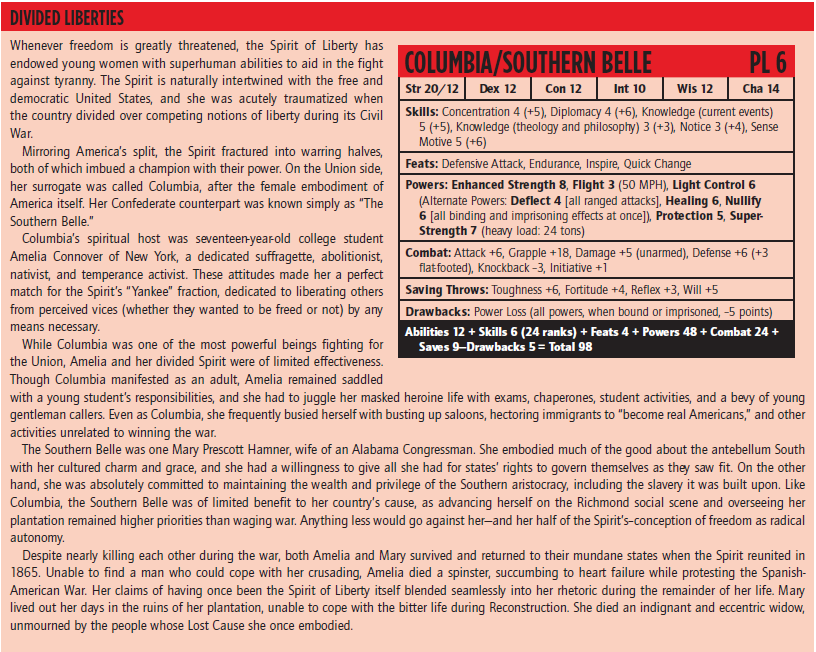
Even as an 18 year old kid picking this up in 2007, this did not sit well with me at all. For a proper context, the modern-day Lady Liberty superheroine is part of the Freedom League, who are the Freedomverse’s Justice League expy. They are a non-governmental organization, which has at alternate times allied with and fought against the US government, the latter particularly during the Iron Age of the 1980s.
Being very much against the Iraq War and seeing its devastating effects, as well as learning the various times said government abrogated the Constitution, this sat well with my conception of the superheroine. America’s inspirational ideals are such that our government is bound to run up against them, so an independent team seemed best for someone channeling the spirit of American Liberty.
But when I read Wars for Freedom, the Southern Belle’s pro-slavery attitude, and Columbia being an ineffectual anti-immigrant zealot, pretty much shattered my view that the Spirit of Liberty was in fact concerned with well...Liberty. My headcanon thus was that Lady Liberty was empowered more by what Benjamin Franklin as dubbed two wolves and a sheep voting on what to have for dinner. The Spirit manifested as what the majority of the American people conceptualized liberty to be at the time, rather than what it is. One could definitely make arguments about the North and the Union’s own tyrannical methods (particularly the American Indian Wars), but the idea of a racist slave owner channeling “liberty” is so ludicrous that I cannot see it being used in any respectable gaming sessions.
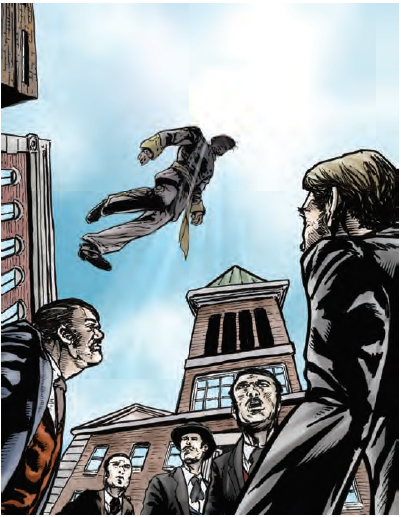
Wars for Freedom Series
Our final section gives some short role-playing notes for respective time periods and tropes, although nothing in-depth enough that you can run an authentic-feeling 1776/1860 game without doing a boatload of research.
“Back in George Washington/Abe Lincoln’s Day…” are short sections describing common foods and social occasions along with what ideas are considered radical at the time.
Back in Abe Lincoln’s Day posted:
In the 1860s, much of 18th Century America remains more or less intact, especially in the South. The further North a person travels, the more aspects of 19th century life assert themselves. Around the Mason-Dixon line, slavery and agriculture begin to give way to immigrants and industry, and railways point the way to the untamed American West. Manners and customs change along with the geography. Traditional courtly Southern manners and archaic codes of honor vanish, replaced by less genteel folk coping with 14-hour workdays at the factory. Southerners continue to chat about the weather, crops, and chinch bugs, while Northerners discuss the stock market, the wonders of steam power, and radical new ideas like women’s suffrage and the temperance movement.
In short, America is a country divided between past and future, as well as what the nation is and what it might become. These differences were so profound they led to war, and driving home the contrast is key in getting across the spirit of the age to the players.
I find it funny how the Northern factory laborer day is emphasized in-text, even though Antebellum slaves had similar if not longer work schedules from dawn to dusk.
We get some brief rundowns of Freedom City in this era: in Colonial Times it had British immigrants along with Puritan and Dutch founders, with Happanuk Indians living nearby. Some neighborhoods from the modern-day sourcebook were independent settlements, and most people’s lives focus around religion and chores. By 1860 the City grew a lot, with many rail lines connecting to other places. The West End housed a lot of immigrants, especially Germans, Italians, Greeks, and Jews, and the waterfronts were busy with steamship traffic. Being a haven for soldiers, spies, abolitionists, runaway slaves, and partisan firebrands, costumed mystery men were not all that unusual given the behind-the-scenes factionalism going on everywhere.
We then get some notes about character creation, with PL 6 as the default standard. Just enough to be powerful in comparison to the average human, but not so powerful that the team can fly/teleport to Richmond/Washington DC to end the war.*
*Granted this is still possible with an assortment of the right powers such as Invisibility, particularly if heads of state and bodyguards are not super-powered. Additionally the USA/CSA government is structured so that a Presidential assassination will just pass down the chain of command, meaning that a behind-the-scenes mind controller is a much better method than straight-up punching Jefferson Davis in the face.
quote:
This is why the characters in this chapter mostly consist of those considered unfit for military service: women, blacks, the elderly, the disabled, and space aliens. This historical facet can result in the creation of some truly diverse characters and allow the GM to address the realities of life during these time periods. However, if the players would simply rather not deal with this limitation, feel free to disregard reality in the best comic-book tradition and go with whatever’s most fun.
Errr...all of them joined the respective super-teams, there’s only one black character, Achilles served in the traditional military before being promoted, and half of both team’s members are (or can pass for) white dudes.
We also get rules on period-appropriate firearms: Revolutionary War flintlocks required six rounds to reload, while cap and ball Civil War era revolvers function just like their modern counterparts. Both era’s weapons also can Critically Fumble on a roll of natural 1 (or 1 and 2 for flintlocks) in a harmless misfire.
We then talk about military-centric campaign advice, which we can basically sum up as “sidekicks are common, codes against killing are counterintuitive, provide mission parameters than aren’t just ‘kill all these dudes,’ and going on furlough can serve for a nice break for alternative stories.”
Overall Thoughts: Unlike Deadlands’ Rebel Wankfest, Wars for Freedom tried to pull off the Both Sides fallacy and the States’ Rights card. However, this is still jarring on account that the Confederacy in this timeline still has slaves, and although portrayed as more “heroic” the Knights of the Confederacy included a tragic slave owner who became friends with the not-Superman analogue. Even though having Freedom City divided and a Union superteam makes this chapter ostensibly neutral, the fact that the Knights overall had happier endings and “good guys” smacks of favoritism.